Don't wanna be here? Send us removal request.
Text
I really enjoyed your analysis. I never thought about how Eleven was sort of a "canvas" that others could portray their idea of her identity, whether it was Dr Brenner, Mike and the boys, Hopper, etc. Do you think the show ever explores representations of gender outside of just the binary? Does eleven ultimately craft her own individual identity not bound by either binary representation?
@theuncannyprofessoro
Performing Gender: Eleven in "Stranger Things"
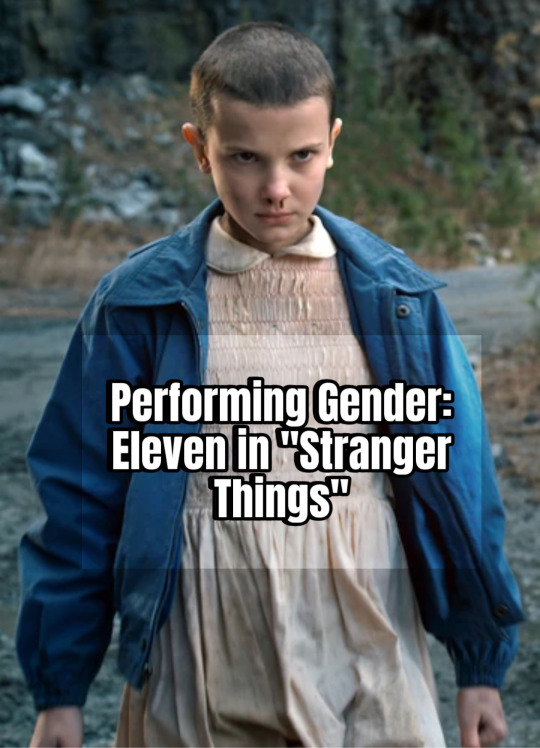
"Stranger Things," a popular science fiction horror series created by the Duffer Brothers, unfolds in the 1980s within the fictitious town of Hawkins, Indiana. Blending supernatural elements with a nostalgic homage to '80s pop culture, the narrative centers around a group of kids whose lives take a peculiar turn when they encounter Eleven, a mysterious girl possessing psychokinetic abilities. Across multiple seasons, the characters face unforeseen challenges, navigating the eerie and terrifying forces that invade their small town. Via the character of Eleven, “Stranger Things” reveals the performative nature of gender, challenging binary definitions. Although her journey is fraught with others imposing their own idea of “her” gender, on how she should look, dress, act - she ultimately becomes a vessel for their own respective will, changing with each of them and showing how gender identity is fluid and performative.
The character of Eleven in “Stranger Things" appears to the viewer in Season One as an empty canvas, free of individuality, gender, or identity after she had escaped from a secret government lab. Eleven, in addition to her supernatural powers is therefore situated as “other”, uncomfortably outside, androgynous and unknowable. Both viewers of, and characters in “Stranger Things", use Eleven as a template for their own visions, creating identity through her appearance. From the beginning, Eleven is nearly nonverbal, speaking only a handful of words per episode. This makes the weight that her appearance plays in our collective evaluation of her that much more critical.
Over the course of two seasons, Eleven undergoes several transformations, each portraying a distinct identity for her character. Initially, Eleven seems devoid of individuality, gender, or a defined identity. In Judith Butler’s “Gender Is Burning”, she writes about the action of being performative, of showing how enacting social identities requires one to perform according to certain “laws”. Butler adds onto Althusser’s “Theory of Interpellation" which states that we internalize cultural values and ideologies through “laws”, which can be thought of as social norms, and that is what forms our identity (1).
Throughout the beginning of the first season where Eleven is initially nearly naked, to the ending of the second season where Eleven is viewed as a normal teenage girl, her hair and clothing show different embodied identities that others have imposed on her, of how they think she should look like. Butler argues that an individual's gender is not an inherent identity but rather a performance shaped by anticipated, repeated, and ritualistic expectations regarding appearance and attire. The imposition of these varied styles on Eleven does not define or articulate how Eleven perceives and comprehends herself, aligning with and confirming Judith Butler's theories on gender expression and appearance as performative.
Throughout the series, we see Eleven as both vulnerable and strong, damaged and super-powered, androgynous and feminine. She is hard and soft, in other words boyish and girlish, as determined by stereotypical notions of gender. All of these characteristics are quite literally embodied in her physical appearance, especially in her hair and clothing. Throughout history, the representation of a community's values has often been concentrated in these visual elements associated with women, signifying social class and attractiveness in the time period of the 1980’s. As Butler highlights, individuals who deviate from prescribed gender norms often face societal repercussions, illustrating the enforcement of these norms. An example in “Stranger Things" that highlights societal repercussions for Eleven's deviation from prescribed gender norms occurs when she ventures into the world on her own. In Season 2, Eleven adopts a more independent and self-reliant lifestyle, this decision results in her facing scrutiny and encountering obstacles from both individuals and societal norms that expect conformity.
From Season One to the end of Season Two, Eleven has her appearance changed, or “dismantled” four times. In her initial Season One appearance, Dr. Brenner was the creator of her appearance: she has a shaved head, appears undernourished, and is wearing only a mere hospital gown. Next, the group of boys dress her up and give her a pink dress, a long blonde wig, and a blue windbreaker. At the start of the second season, Hopper, who is hiding her from everyone, dresses her; she now has her naturally curly brown hair and is first seen in a flannel to match the one he is wearing, and later switches to overalls. This is succeeded by a punk-rock makeover given to her by her “sister” Kali; featuring slicked-back hair, dark eyeliner, lipstick, and a black blazer. Notably, each makeover is orchestrated by other characters with minimal input from Eleven herself. Her evolving appearance serves as a reflection of what other characters in the show, and by extension, the program's creators, believe she "should" look like.
I want to focus on Season 1, Episode 4,when the boys set out to dress Eleven according to what they expect a girl to look like. By making Eleven into a “pretty” girl, the boys have remade her as a person who fits the conventionally accepted elements of appearance for a young girl, who is delicate and weak. Upon her transformation, Dustin and Mike marvel, "Wow, she looks... pretty". Eleven swiftly internalizes this lesson, repeating the word "pretty" as she gazes at herself in the mirror. The act of making her "pretty" diminishes her power and agency. By calling Eleven "pretty," it makes her fit into the conventional idea of how girls are expected to look and act within traditional male-female relationships.
In addition to Eleven's adoption of a feminine wardrobe, whether it's a choice of her own or not, being supernatural and possessing strong powers can often lead characters in the show to see her as “other” and dangerous. As she possesses these superpowers, she can embody a more masculine role and potentially blur the boundaries of the gender binary, therefore “othering” her. Furthermore, the age of characters, such as Eleven, plays a crucial role in shaping how they are perceived as threatening or nonthreatening. In Eleven's case, her supernatural abilities, which are often portrayed as othered and demonized in media, are juxtaposed with her role as a vulnerable victim of trauma within the friend group of boys who aim to protect her. The juxtaposition of supernatural powers with vulnerability creates a nuanced dynamic that challenges conventional expectations. Despite possessing abilities that might typically be associated with threat or danger, Eleven's young age and the trauma she has experienced position her as more of a victim in need of protection, conforming to traditional gender norms of men being the protectors of women.
(1) Butler, Judith. “Gender Is Burning: Questions of Appropriation and Subversion.” Gender Trouble: Feminism and the Subversion of Identity, Routledge, 1990, pp. 381–383.
5 notes
·
View notes
Text
Your comparison to Judith Butler's perspective on representation and gender norms in Paris is Burning gave an intriguing analysis of the characters in the show. It's interesting to note how, despite the show's diverse cast, certain characters, particularly women in positions of power, might not receive the narrative attention they deserve. In my analysis, I also used Judith Butler's research, but I thought the show I looked at (Gravity Falls) did a much better job of subverting the traditional binary norms of gender representation. I wonder if the genre (live-action thriller vs cartoon) has anything to do with that.
@theuncannyprofessoro
Dark (2017) Final Project

The thriller and mystery series Dark (2017) is the first Netflix original show to be German. The narrative follows a fictional town in central Germany called Winden that is shrouded in controversy. The series begins with a father committing suicide, leaving his son, Jonas, traumatized and in therapy for a couple of months. Two children, ages twelve and fifteen, go missing without a trace as well. Weird occurrences such as birds and sheep suddenly dying of cardiac arrest with ruptured eardrums appear to have some connection to the unexplainable happenings. While not much is revealed at first, with each passing episode we learn more and about how everything is tied together through time travel. Ulrich Nielsen, a police officer, is the father of the twelve-year-old-boy who went missing named Mikkel. When Ulrich was a teenager, his younger brother, Mads, similarly went missing at the age of twelve. We soon come to realize that Mikkel time traveled back to 1986, while Mads was sent to 2019. It is later revealed that Mikkel stayed in 1986 and is the father of Jonas, who committed suicide at the start of the series. In ways like this, everything in this show is tied together in mysterious ways.
While the show is set in a small town in Germany, meaning every character is white, the series is quite diverse. The show has multiple deaf characters, transgender characters, a husband who is secretly homosexual, and a vast array of women in positions of power within the town. However, American philosopher Judith Butler writes in her article “Gender is Burning: Questions of Appropriation and Subversion” on how a diverse cast does not mean positive representation. Butler writes on the documentary Paris is Burning (1990) and how it “calls into question whether parodying the dominant norms is enough to displace them; indeed, whether the denaturalization of gender norms cannot be the very vehicle for a reconsolidation of hegemonic norms.” [1] Although a woman is the principal of the town’s high school or the chief of police, these characters are not particularly developed or a crucial part of the narrative. Ulrich’s wife, Katharina, is the principal of the high school and also Mikkel’s mother, yet the series focuses much more on Ulrich’s struggles despite him just being a police officer. The show divulges into Ulrich’s past, where he often times got into trouble with the local police and his unlikely journey to eventually becoming a member of the police. It also displays how Ulrich was framed for raping Katharina when the two were in high school by Hannah. In 2019, Ulrich is cheating on Katharina with Hannah, not knowing that she was the one who framed him back then. We see his efforts in attempting to break into illegal areas without a warrant in an attempt to find his son, Mikkel, while Katharina is largely forgotten. The chief of police, Charlotte Doppler, is often times just a hindrance to Ulrich’s efforts. As Butler argues, placing characters outside of their gender norms does not mean the show is inclusive, and Dark seems to fail in this regard by pushing male characters to the forefront of the narrative.
Furthermore, the series eventually settles on a male protagonist despite its initial focus on a vast array of characters. Butler explains that “heterosexual privilege operates in many ways, and two ways in which it operates include naturalizing itself and rendering itself as the original and the norm.” [2] Jonas, who’s the son of Mikkel and Hannah, eventually becomes the character we follow as he time travels back to 1986. The show gets the viewer to share his point of view from the start when he finally returns to school after two months. His best friend, Bartosz, has told everyone that his absence is due to being on a study abroad in France. Jonas is not particularly delighted by this excuse, and further feels betrayed when he realizes that Bartosz is dating Martha, a girl who he was with over the summer. Characters like Martha often become a love interest for a prominent male character or a subject of the male gaze within the series and are not particularly developed.
Another character that fits into this category is Franziska Doppler, the daughter of the chief of police, Charlotte. Her character is quite developed at first, unlike many of the other female cast. We discover that her eight-year-old sister is deaf but quite mischievous, leading to them often fighting. Her mother and father live together but are in the process of getting a divorce because the father is homosexual and has had multiple affairs. We realize that while Franziska is a model student on the surface, she carries a lot of emotional weight on the inside. Yet her character is often the subject of the male gaze. British feminist film theorist Laura Mulvey writes in her article “Visual Pleasure and Narrative Cinema” on the objectification of women in cinema. Mulvey writes that “a woman performs within the narrative, the gaze of the spectator and that of the male characters in the film are neatly combined without breaking narrative verisimilitude.” [3] In episode four, Franziska is shown changing into her dancing clothes in the women’s locker room while Magnus, the older brother of Mikkel, spies on her. Magnus continues watching her through the window of a door as she practices with her dance class. Later, as she changes back into her regular clothes, Magnus enters and confronts her. She then confides to him about her domestic life and her internal struggles, leading them to kiss. While her character is complex, she quickly becomes just another love interest for a male character and the audience to gaze at.
While Dark is a well written and entertaining series, its attempts at diversity feel engineered and not particularly effective. While it is admittedly difficult to create complex characters with such a large cast, the narrative feels too male oriented at times while trying to create the appearance that female characters are also prominent. Rather than giving fancy titles to some of the woman in the show, having one of the children that go missing being a girl, or having female characters that are not always love interests may have created a more inclusive series.
[1] Judith Butler, “Gender is Burning: Questions of Appropriation and Subversion,” Feminist Film Theory, (1999): 338
[2] Butler, “Gender is Burning: Questions of Appropriation and Subversion,” 339
[3] Laura Mulvey, “Visual Pleasure and Narrative Cinema,” Film Theory and Criticism, (2009): 716
#oxyspeculativetv #speculativetvanalysis @theuncannyprofessoro
youtube
7 notes
·
View notes
Text
This was a great analysis! I watched the show a few years ago and never thought about the binary system of gender that the roles of Eleanor and Chidi seem to fill. The show's exploration of ethics and the afterlife provides a unique backdrop to examine societal expectations and gender roles.
@theuncannyprofessoro
Critical Television Analysis: The Good Place

On the surface, The Good Place is well-loved, hilarious, and surrounds a diverse cast with characters that differ from identity-related stereotypes. The show surrounds Eleanor, who wakes up in heaven, referred to as the “Good Place,” alongside Tahani, Jason, and Chidi (who is labeled her soulmate). Michael is the supposed leader of the “Good Place,” but we later discover that–in alignment with Eleanor’s selfishness–he is actually a devil and this is the “Bad Place.” The characters’ out-of-placeness (except for Tahani and Chidi, who initially think they belong) is meant to be their eternal torture, but Eleanor’s repeated solving of this mystery results in endless reboots and failures. The series ends when the humans team up with Michael and they realize that the entire system is off, as everyone is being sent to the “Bad Place” based on its unattainable, binary measures of morality. They successfully reform the system, resulting in Michael’s transformation into a good being–and living out his fantasy of being a ‘human’ on Earth–and Eleanor, Chidi, and Jason transforming into blissful nothingness while Tahani helps to design a better afterlife.
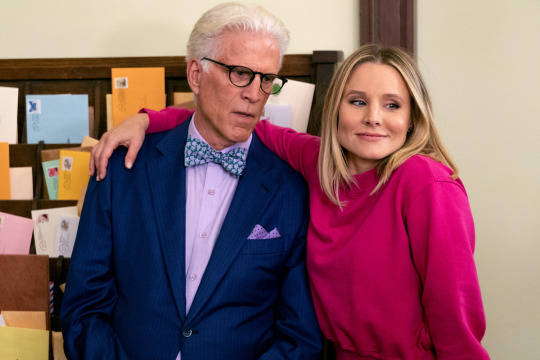
Photo: Michael and Eleanor.
Although we eventually learn that everyone is being sent to the “Bad Place,” the show’s group of focus is diverse (through their sexuality, gender, or race), generalizing “Bad” people to be those who defy hegemonic norms. This mirrors our current society, especially with those in control being white men (like Michael & the other Devils, and one white female judge) with outdated ideology–I explore this further in my video essay. While the final message of the show recognizes this point system as flawed, revealing the lack of a binary good/badness (the main point of my video essay), it doesn’t at all explore the sexual, gendered, and racial aspects of the characters’ intersectional experiences, making the show more hegemonic than not. I analyze the portrayal of specific characters and how these may be negatively interpreted by viewers despite this show’s positive overall message.

Photo: Tahani, Jason, Eleanor, and Chidi as they stand before the judge and request the chance to 'start' life--and their "Good" vs "Bad" point count--from scratch.
I critique responses to The Good Place that commend its progressiveness based on the fact that its cast is racially diverse and they don’t align with traditional stereotypes, and instead suggest that in this case, “not all representation is good representation” (Hsu, 2021). The show fails to reconstruct intersectional identities in a positively ‘different��� way due to its “color-blind” approach, which disregards, rather than reconstructs, gendered and racialized oppression throughout history. The non-hegemonic aspects of characters’ racial or gender identities are dampened through their adoption of traits that reinforce hegemonic ideology; this is particularly prominent among the female characters, however I address the male characters prior to my conclusion. Primarily, each female character represents an atypical, but similarly problematic form of femininity that continues to reflect the male gaze; Eleanor’s narrative control as a woman is dampened through her alignment with hegemonic masculinity–this is heightened by Chidi’s femininity (perpetuating an innate gender binary), Janet’s non-binary identity is overridden by their similarity to the ideal, domesticated woman (reasserting heteronormativity as the norm), and Tahani’s Pakistani background is misportrayed through her assumption of a privileged white-washed identity (making racial histories invisible) (Kaplan, 2010). Kaplan, Shohat, and Diawari note that the significance of media’s portrayal of gender and race lies in its influence on the minds of its viewers; what media constructs is perpetuated and eventually, realized within our own reality, pointing to the significance of recognizing ideological media as such before its perpetuation. While the presence of three female characters in the show’s main ensemble provide us with the illusion of gender equality, upon closer analysis it is clear that each reinforces problematic stereotypes surrounding race and gender.

Primarily, the protagonist is a white woman–the show opens with a shot of her face, bright and glowing, and follows her perspective throughout the narrative. Eleanor’s non-feminine, general indifference is framed as the essence of her personality, and resultantly, the reason behind her punishment. Kaplan notes that attempts to reconstruct female characters in defiance to gender norms can fail through their consistent creation of a male/female binary; “our culture is deeply committed to clearly demarcated sex differences.” Eleanor illustrates Kaplan’s point that emerging female “representation” remains binarized, as she adopts a specifically masculine position that is characterized by her lack of “traditionally feminine traits,” particularly, her “cold and manipulative” personality (Kaplan, 2010). Flashbacks of Eleanor’s life on Earth revealed that everyone hated her because of her manipulative ways and carelessness surrounding others’ feelings. On Earth, Eleanor used to get drunk before going out with her work colleagues on the night she was designated driver, just to joke that the only place she’d be driving was through the “loophole” she found in the system… When she’s (finally) forced to stay sober and drive, she pretends to be doing it out of care for her friends to get the bartender’s attention, and later chooses going home with him while stranding her drunk friends at the bar. Needless to say, Eleanor isn’t invited to go out with her colleagues again.

This careless emotionlessness is counteracted by Chidi’s “kindness, humaneness, and motherliness,” evident in the fact that his personality surrounds his nervous awkwardness and indecisiveness based on a desire to make the most moral, utilitarian decisions possible (Kaplan, 2010). Many viewers think Chidi illustrates “positive masculinity,” but his emotionality and indecisiveness–alongside a resulting inability to “take action” in the way Eleanor does–suggest he may align with the feminized role as described by Kaplan (Kaplan, 2010). Moreover, Chidi is used to counteract Eleanor’s masculinity and keep the gendered binary “structure intact” despite the supposed stray from hegemonic gender norms (Diawara 2014, Kaplan, 2010).
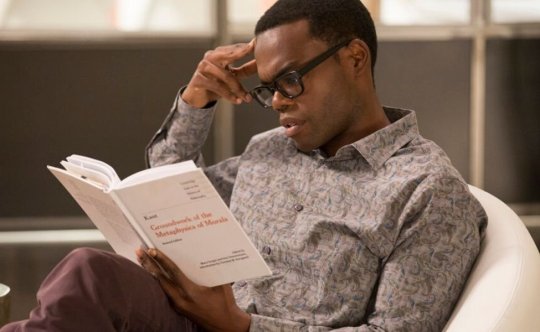
The idea of Eleanor’s defiance of traditionally feminine gender norms is directly framed as related to her “badness” through her narrative arc, in which her transformation into a “good person” directly aligns with her acceptance of hegemonic femininity; she adopts “kindness, humaneness, and motherliness” and heteronormativity (Kaplan, 2010). When the humans are given the chance to live again and restart their point count, Eleanor struggles; as soon as Chidi kisses her and they recognize their feelings, she finally does better on Earth and becomes “good.” While one could argue the arc’s alignment with heteronormativity is purely coincidental, it contrasts with the show’s previous focus on Eleanor’s bisexuality, aka, its queerbaiting of Eleanor. Throughout early seasons, Eleanor frequently commented on Tahani’s attractiveness, and even came close to kissing Simone (Chidi’s gf at the time); the usage of her bisexuality is, in itself, framed inappropriately comically, and coincides with her previously “masculine” traits– carelessness, moral indifference, and lack of romantic interest in Chidi–suggesting non-heteronormativity to be similarly negative. Moreover, the fact that Eleanor is a woman does not necessarily mean she’s a progressive character, as is evident in her adoption of a non-feminine, but similarly binary form of masculinity, the presence of Chidi as a feminine counterpart , and the show’s aligning of her bisexuality with “badness.”
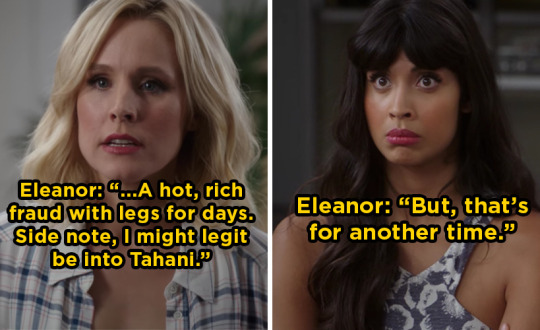

Photo: Eleanor and Tahani
Janet, a white character, is framed as the perfect woman, which is problematic due to their identification as non-binary, both because it is transphobic and frames servitude (her main purpose) as innately feminine. Primarily, I noticed that Janet mirrors our assignment of femininity to technological sources of servitude: Siri, Alexa, GPS navigation, “the number you have dialed is not in service…” Like these objects, Janet’s “servitude and obedience” are viewed as innately feminine, and are thus assigned a feminine identity (James, 2018). Despite Janet’s attempts to reclaim their lack of alignment with societal labeling norms through the consistent assertion that they are not female, but rather a vessel of knowledge (equating themself to AI), characters always call them a “girl.” Janet never argues with this misgendering, and instead responds with a smile and a kind, “Once again, I’m not a girl” (Beck, 2023). While Janet’s character could have been an opportunity to explore a non-hegemonic perspective, the show harms non-binary identities more than it supports them, by enabling characters to misgender Janet and using their feminine appearance (always fresh, made-up, and in a dress) and feminine subservience to justify this assumption as comically obvious and justifiable (Beck, 2023). The show actually perpetuates their femininity so much that their character is referred to as a girl both within and out of the narrative (among characters and audience members). In the end, Janet is framed as a woman in nature despite their assertion of being non-binary, both aligning femininity with object-ness and servitude and framing non-binary identities as lacking personhood. The show uses Janet as a diversity point without truly questioning binarized views of gender; Janet’s consistent positivity and agreeability disregard the harm of misgendering, and actually works to justify the characters who misgender her by framing Janet’s “femme” physicality and personality as evidence of their ‘obvious’ femininity (Beck, 2023).

Just as Janet’s intersectionality is subdued through their over feminization, the only other intersectional identity (and the only non-white woman) of focus–Tahini–is made palatable through the show’s white-washing of her personality. While Tahani is a first generation Pakistani in the United Kingdom, her struggle-free experience in white-dominated high society disregards a perspective representative of non-white culture, and instead hides it with a British accent and Tahani’s infinite wealth. Tahani’s lack of race-related struggles are completely disregarded through her defining trait: selfishness. Even her greatest deeds, such as organizing charities on Earth, were all based on selfish intentions surrounding her parents’ validation. Her biggest struggle is framed as her sister’s fame, specifically, her parents’ heightened love of her sister, which aligns with Tahani’s inherent self-focused attitude. In this way, UK’s historical colonization of Pakistan and the current othering of British Pakistani are made invisible. (Aljazeera, 2023). As noted by Shohat, attempting to re-frame gendered and racial history (patriarchy and colonialism) is not always done in an “unproblematic” way, just as The good Place’s color-blindness to Tahani’s racial history actually perpetuates social ignorance of historical oppression. In alignment with Shohat’s explanation of the “mark of the plural,” in which any “negative behavior” (Tahani’s personality-defining selfishness) is viewed differently based on the characters’ race, Tahani’s characterization is more likely to be generalized to Pakistani people than Eleanor’s would be to white people (Shohat, 2014). Tahani’s obliviousness to her culture’s oppression projects a falsely generalized idea of this racialized history as insignificant among Pakistani despite its continued prevalence.
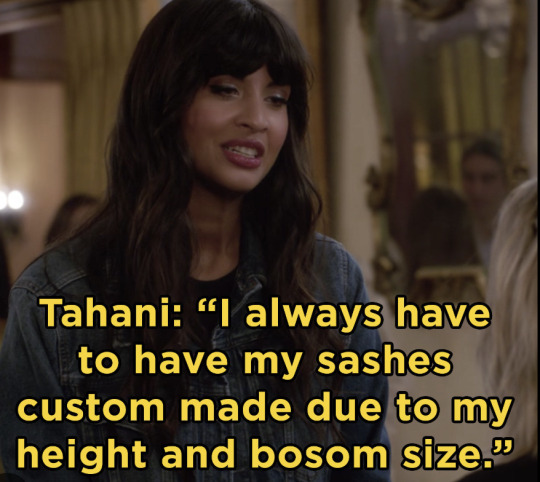
While I mainly focus on female identities (complicated by Janet), The Good Place frames the experiences of Jason, and Chidi (in addition to Tahani) as completely unaffected by their race. Jason’s ability to pass as a Taiwanese monk due to him being Asian–despite the fact that he’s from Florida and is not a monk–perpetuates essentialist ideology surrounding sameness based on race, and his heightened lack of intelligence is a poor choice for the only Asian representation throughout the show. Chidi’s violation of hegemonic masculinity (through his emotionality, indecisiveness, etc.) being framed as the reason he resides in the Bad place aligns with problematic characterizations of Black characters “playing by hegemonic rules and losing” (Diawara, 2014). More broadly, the fact that Chidi, Jason, and Tahani are supporting characters for a white woman–like many other characters of color–repaints white-washed film narratives in which POC don’t hesitate to “protect” the “same order that has punished and disciplined” them (Diawara, 2014).
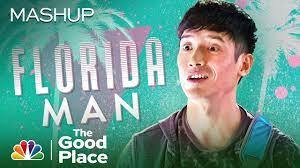
The afterlife’s similarity to Earth suggests its culture as to be reminiscent of our own, however, the color-blind attitude of the main characters disregards the rampant racism that we still work to subdue. Unfortunately, The Good Place’s opportunity to explore an array of perspectives and lived experiences through characters’ diverse backgrounds is lost, even just based on the nature of their show; they do not take into account that the negative representations assigned to each of its characters have a different impact on their community. The fact that a white man created “The Good Place” isn’t surprising, and points to Shohat’s recognition of the necessity for “historically marginalized” groups to “control their own representation” to avoid reproducing something from a white audience’s lens of “pleasure” (Shohat, 2014).
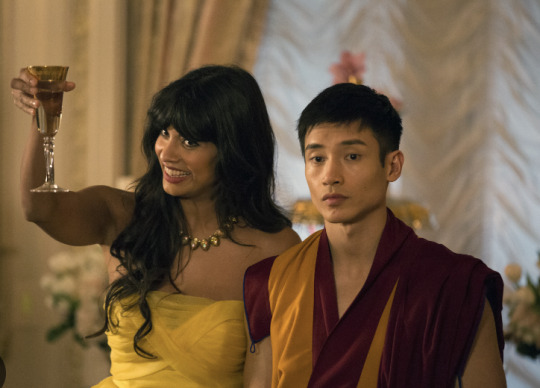
Photo: Tahani and Jason.
Works Cited:
Beck. “‘I’m Not a Girl’: Janet, Nonbinary Representation and ‘The Good Place.’” The Spool. Accessed December 12, 2023.
Diawara, Manthia. "13 Black Spectatorship: Problems of Identification and Resistance." Black American Cinema (2012).
Hsu, Leina, Ruchi Wankhede, Ayan Omar, and Jennifer Ammann. “No, the Good Place’s Jason Mendoza Does Not Defy Asian Stereotypes.” Women’s Republic, March 1, 2021.
James, et al. “The Other Secret Twist: On the Political Philosophy of the Good Place.” Los Angeles Review of Books, October 13, 2018.
Kaplan, E. Ann. "Is the gaze male?." (2010).
Shohat, Ella, and Robert Stam. Unthinking Eurocentrism: Multiculturalism and the media. Routledge, 2014.
Staff, Al Jazeera. “Braverman Words on British Pakistani Men Discriminatory: Pakistan.” Al Jazeera, April 5, 2023.
@theuncannyprofessoro #oxyspeculativetv #speculativetvanalysis
12 notes
·
View notes
Text
Gravity Falls gender representation analysis

Gravity Falls is an animated TV show created by Alex Hirsch that aired from 2012 - 2016 on Disney. There are only two seasons, but the show has built a dedicated fan base that continues to grow even after its conclusion. The series, set in the mysterious town of Gravity Falls, Oregon, follows the summer adventures of twin siblings, Dipper and Mabel Pines, as they unravel supernatural mysteries, encounter peculiar creatures, and navigate the complexities of family and friendship.
What sets Gravity Falls apart is its unique blend of humor, heartwarming moments, and a narrative that seamlessly weaves together overarching mysteries. Creator Alex Hirsch's clever writing and commitment to character development have left a lasting impact on viewers of all ages. The show's memorable characters, from the lovably eccentric Grunkle Stan to the enigmatic Bill Cipher, have become iconic figures in popular culture. Gravity Falls not only entertains with its imaginative storytelling but also delves into themes of identity, friendship, and the acceptance of the unknown. Gravity Falls' influence extends beyond its on-screen presence, inspiring a myriad of fan theories, artistic creations, and a thriving online community. Its cultural impact is a testament to the show's ability to resonate with audiences and spark discussions on various social and philosophical topics.
By examining specific characters and relationships, including Dipper's encounter with manliness and the unique dynamic between the two sheriffs, we can unveil how the show challenges and transcends traditional gender representations.
Judith Butler's notion of performativity finds resonance in Dipper's encounter with manliness in the episode, “Dipper vs Manliness” (S1E6). In her essay, Butler argues, "That it must repeat this imitation, that it sets up pathologizing practices and normalizing sciences in order to produce and consecrate its own claim on originality and propriety, suggests that heterosexual performativity is beset by an anxiety that it can never be finally or fully achieved, and that it is consistently haunted by that domain of sexual possibility that must be excluded for heterosexualized gender to produce itself” [1]. In other words, Butler explains despite the efforts to adhere to established norms, there is a persistent fear that the performance of heterosexuality is never fully achieved or secure.
The episode begins with Dipper wanting to win the approval of Stan and Mable by scoring high in a “Manliness tester” game. They both laugh at the idea of Dipper being “manly.” Frustrated, Dipper plays the game but gets the lowest level, wimp. Later on, he meets a mythical creature in the forest, called a Manotaur. These large bearded creatures embody all of the stereotypical “manly” qualities Dipper seeks–tall, deep voice, chest hair, buff. The creature brings Dipper to the “man cave” where all of the Manotuars live. In order to join the clan, Dipper must pass a series of tests to prove his manliness. At the final test, Dipper folds and accepts that he is not the “manly” person he hoped to be. He expresses his feelings to the Manotaurs, saying: “You keep telling me that being a man means doing all these tasks and being agro all the time, but I’m starting to think that stuff’s malarkey.”
Dipper's reluctant participation in the “manliness tests" reflects the performative nature of gender. The episode deconstructs traditional notions of masculinity by showcasing Dipper's discomfort with stereotypical expressions of manliness. His resistance to conformity challenges the established gender norms within the narrative.
It’s not uncommon for the series to use a mythical species to represent certain stereotypes or insecurities. In this episode, the Manotaurs are the portrayal of Dipper's insecurities of gender performativity. The Manotaurs other Dipper and his characteristics by making him feel inferior to their exaggerated, hyper-masculine standards. This not only highlights the external pressures individuals face in conforming to societal expectations of masculinity but also underscores the detrimental impact of such expectations on one's self-perception. Gravity Falls skillfully employs fantastical elements to delve into real-world issues, encouraging audiences to critically examine and challenge societal norms surrounding gender and identity.
Creator Alex Hirsch likes to hide subtle clues of LGBTQ representation in certain characters (he’s explained many times that it’s insanely hard to get most things through Disney’s censor). However, the relationship between Sheriff Blubs and Deputy Durland seems to be the most clear example. The two characters are the town’s police officers, who appear as recurring characters in many episodes. The dynamic between Sheriff Blubs and Deputy Durland provides a fascinating exploration of gender representation. The duo subverts expectations by embodying traditionally masculine roles in law enforcement while also sharing a close bond that challenges traditional expressions of masculinity. They share a close bond, expressing things like, “The time we spend together is treasure enough,” and “Edwin darling, you are a diamond in the rough.” In almost all Western depictions of police officers, they embody hyper-masculine traits, as being fearless and stoic seems to be inherently part of the job. The sheriff’s dynamic challenges the binary understanding of gender, showcasing the fluidity inherent in Butler's theory. In the last episode, their romantic relationship is confirmed: “We’re mad with power… and love,” they declare while looking into each other's eyes. Creator Alex Hirsch also confirmed this at a charity event, and has repeatedly explained how hard it was to get past Disney’s censors. Hirsch has also revealed dozens of scenes originally written to have openly gay characters that got slashed by Disney. Unfortunately, a company as big as Disney has ultimate power over what is and isn’t aired. While there isn’t any other direct LGBTQ representation in the show, the blame should be put on Disney, not Alex Hirsch. Most likely Disney provided the outlet for him to create this show, but in turn, blocked many of his creative ideas.
Gravity Falls, through the characters of Dipper, Sheriff Blubs, and Deputy Durland, becomes a compelling exploration of gender representation. The show aligns with Judith Butler's gender theory by deconstructing traditional norms, emphasizing the performative nature of gender, and challenging the rigidity of binary constructions. Dipper's resistance to manliness and the nuanced dynamic between Sheriff Blubs and Deputy Durland collectively contribute to Gravity Falls' progressive portrayal of gender identities. In doing so, the show invites audiences to question and redefine societal expectations, demonstrating the transformative potential of animated narratives in challenging and reshaping cultural perspectives on gender.
[1] Judith Butler, “Gender Is Burning: Questions of Appropriation and Subversion”, New York University Press, 1999, 338-339.
@theuncannyprofessoro
11 notes
·
View notes
Text
Does the show's anthology-style narrative ever seem to lose momentum in the arc of the series? I would imagine it would be harder to maintain engagement when each episode is like a mini story.
@theuncannyprofessoro
The Boys: Diabolical Roundtable
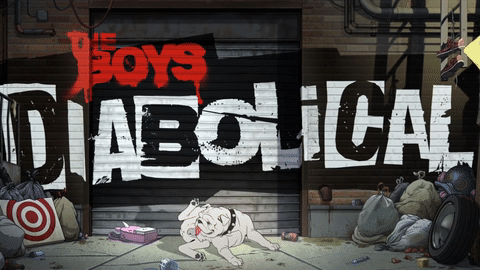
How do structural mythology, cultural studies, and cultural history reflect the series’ world and world-building around superheroes?
As an intellectual property as a whole, The Boys constructs an at times scarily possible structural mythology around superheroes. Although to the public of the world they live in Vought presents the typical mythology of a powerful superhero that does anything and everything for the common good of the common person, structuring the mythology of The Seven into what we think of as a typical comic book superhero, as a viewer we are privy to what truly goes on beyond the news cameras and headline stories. The world and heroes that The Boys constructs are reflected through the cultural studies and cultural history of America through this gilded dynamic of what is presented in the media covering up what truly happened. The Boys: Diabolical hones in on this dynamic through a series of vignettes exploring what absolute power and media control can do—especially to the common person—engendering the cultural values and fears of our current time while simultaneously adding a new portrayal of literal and figurative power to our cultural understanding of it.

In what ways are the superheroes and their abilities informed by their racial, gender, sexual, and cultural identities? Unlike many characters’ powers and roles in The Boys, the superpowers in Diabolical are mostly random. For the most part throughout the show, this is due to how superpowers are largely used to comedic effect, whether that be a silly power or comedic (but still gratuitous) violence. However, of the characters that appear from The Boys in Diabolical, there are two clear standouts; Homelander and Black Noir. Both were created by Vought, the ultimate conservative post-capitalist conglomerate, to play very specific roles heavily informed by their racial and gender identities. Homelander, a blonde-haired, blue-eyed white man who was essentially made in a lab to be Vought’s all-American poster boy serves as the pinnacle of a conservative pro-social message, while Black Noir, a black man who has been effectively silenced by Vought is used for his skills and abilities but is unable to speak or be his own hero.
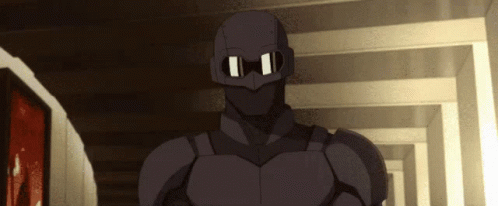
In what ways do costumes and concealing identities further separate the superheroes from normal society? How necessary is it for the superheroes to hide their true identities to successfully achieve their goals?
Unlike many superheroes of the past, Diabolical exaggerates The Boys' distinct lack of superhero anonymity. Aside from the various stories centering around individuals' experiences with “Compound V,” almost all of the superheroes that appear in the show are not hidden behind masks but rather deliberately seeking attention from the public both to raise their “ratings” with Vought and to complete personal missions. Diabolical presents an alternative to the idea that a superhero must be a masked figure with no subjective “I” and demonstrates the grim reality of unchecked power and obsession with the “I”. Throughout the series, Diabolical asks; who needs to hide their identity when nothing can injure them in any way? Superheroes and powerful companies like Vought do anything they please in The Boys world and Diabolical dives into the personal consequences of that reality.
How do the economic, political, and social events that occurred during the series’ creation and broadcast cultivate and inform the superheroes’ decisions and actions?
Although this series of vignettes serves well as a comedic and at times lighthearted spin-off version of The Boys, there are particular episodes that explore the cultural history of the time that The Boys was originally adapted into a television series that make it such a powerful reflection of our own world. One particular episode, titled “One Plus One Equals Two,” plays strongly into the fears and anxieties of the concept of “fake news,” a concept that The Boys plays heavily on. However, Diabolical focuses less on media manipulation and more so on the personal effects that it can have on everyday people that are affected by Compound V. In one such episode, titled “Boyd 3D,” two everyday people become addicted to a temporary form of Compound V and their lives skyrocket to fame, only to fall apart just as quickly. The episode explores themes of social media selectivity and the reality behind the moments that we choose to share online with an emphasis on the corrupting effects of such power.
How do the superheroes question themselves, each other, and their obligations and duties to the people around them?
The superheroes in The Boys and Diabolical alike both question themselves, each other, and most of all their obligations constantly. Diabolical, however, has the freedom of unrelated episodes to explore more unique and inventive versions of superheroes and situations. In an episode titled “An Animated Short Where Pissed-Off Supes Kill Their Parents,” we meet dozens of superheroes who have powers that aren’t quite up to the crime-fighting task. However, because they were given those disappointing superpowers by their parents injecting them with Compound V, they were left as children at this school and abandoned by their parents. In the super world of Diabolical, superheroes are not superhumans with unquestionable morality but rather normal people who were thrust into a position of immense power in a world where morality and humanism are no longer a solid truth to stand on.

@theuncannyprofessoro #oxyspeculativetv
11 notes
·
View notes
Text
Does the show portray supergirl to be inferior or weaker than superman? You mentioned they have identical powers, but I wonder if they still depict her as being somehow inferior because of her gender.
@theuncannyprofessoro
Roundtable Presentation: We Don't Need Another Superhero
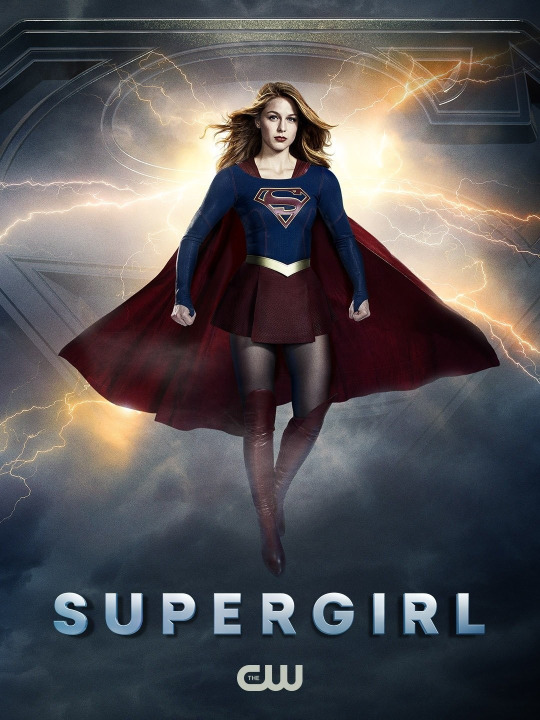
How do structural mythology, cultural studies, and cultural history reflect the series’ world and world-building around superheroes?
Supergirl’s true identity is Kara Zor-El, with her earth name being Kara Danvers. The show takes place in National City, and besides this world’s advanced technology and interaction with the extraterrestrial, it reflects a world much like ours. The politics of this world is similar in the sense that there are “anti-alien” political groups that lead the aliens of this world to find refuge in their own bars, neighborhoods, etc. In fact, Kara’s best friend, Lena Luthor, develops a piece of technology meant to identify who in a crowd is alien and who is not, a severe form of othering.
In what ways are the superheroes and their abilities informed by their racial, gender, sexual, and cultural identities?
One of the main challenges for Supergirl is coming to terms with her identity and finding space for herself in a world dominated by male superheroes, specifically her cousin, Superman (aka Clark Kent). During the destruction of their planet, a teenage Kara is sent to earth to protect baby Clark. However, Kara arrives on earth much later than Superman because she ended up trapped in the Phantom Zone, a dimension of space where time doesn’t exist. Thus, although Kara is older, Clark is already an adult while Kara is growing up with her adoptive family. In a world where a male superhero with identical powers is established, Supergirl has to work twice as hard to make sure she isn’t just known as “Superman’s cousin.”
Another way Supergirl is informed by her gender is through her interaction with other male characters. Most Superman narratives don’t typically focus on Superman’s love interest, and even if it does, it rarely has a large enough focus to affect the trajectory of Superman’s abilities. Contrastingly, the TV show Supergirl is packed with “damsel in distress” storyarcs, where she is often saved by one of her love interests. This is interesting considering one of the main themes of the show is feminism.


In what ways do costumes and concealing identities further separate the superheroes from normal society? How necessary is it for the superheroes to hide their true identities to successfully achieve their goals?
Supergirl's costume separates her completely from her actual identity, Kara Danvers. The importance of the costume especially comes to light when she is interacting with her boss, Cat Grant, and her best friend, Lena Luthor. Both characters have very different attitudes when it comes to Supergirl versus Kara. Cat Grant idolizes Supergirl and aims to secure interviews with her for her magazine while treating Kara, her assistant, with little acknowledgement and appreciation. Lena Luthor, who begins as friends with both of Supergirl’s identities, becomes both vengeful and terrified of Supergirl and strains their relationship even further by developing anti-alien technology that could dampen Supergirl’s abilities. As for her relationship with Kara, the two are the bestest of friends until Kara reveals her superhero identity to Lena, leading to an extreme loss of trust between the two. For Supergirl, it’s extremely important for her to maintain a hidden identity so that her complex work relationships do not get mixed up with her personal ones.
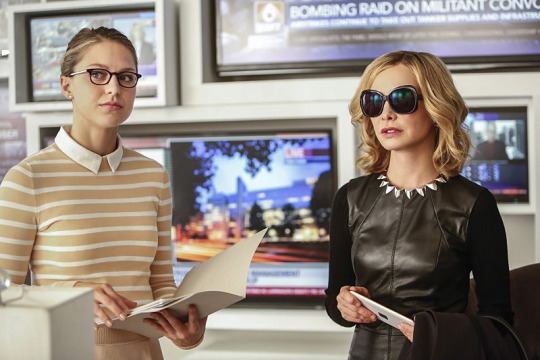
How do the economic, political, and social events that occurred during the series’ creation and broadcast cultivate and inform the superheroes’ decisions and actions?
Supergirl aired in 2015, and in 2016, the election between Donald Trump and Hillary Clinton was the topic of the year. Thus, I don’t think it’s a coincidence that season two of Supergirl had more episodes surrounding the president than any other season. The President in the world of this series was a woman named Olivia Marsdin. However, one of the biggest shocks of the entire series was in the season four premiere, where The President was revealed to be a shapeshifting alien herself. This is especially interesting considering Trump’s stance on immigration during this time. In the world of Supergirl, this revelation threw the public into utter chaos and shock, especially because of the anti-alien sympathizers spread throughout the country. Although the President shows no immediate threat and has been running the country with its inhabitants best interests at heart, both human and alien, the Constitution leaves no room for the President to not be a natural-born citizen, let alone an extraterrestrial. The revelation tarnished the image of aliens all over the country, including Supergirl, and anti-alien extremist groups gained even more support, with one of the leaders, Agent Liberty, becoming the primary antagonist of the season.

How do the superheroes question themselves, each other, and their obligations and duties to the people around them?
Because she has to keep her identities separate, Supergirl often has to hide parts of herself from the people closest to her. Thus, when she’s able to share her full self with someone, it takes an extra emotional toll on her to lose them. During an invasion, Supergirl has to choose between saving the people of Earth from becoming mindless drones or losing the love of her life, Mon-El. Ultimately, she of course chooses to save Earth, but there is a moment where Supergirl questions whether all she has sacrificed for this world both physically and emotionally is worth it or not.

@theuncannyprofessoro
12 notes
·
View notes
Text
Do you think the first few episodes with the different television eras were beneficial to the plotline? Was it too slow or did it seem irrelevant?
@theuncannyprofessoro
WandaVision (We Don't Need Another Superhero Roundtable)
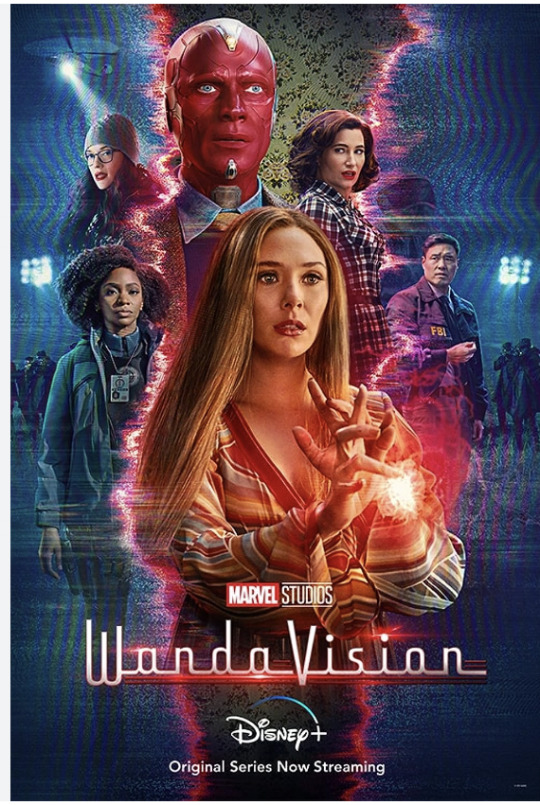
youtube
How do structural mythology, cultural studies, and cultural history reflect the series’ world and world-building around superheroes?
In Avengers: Infinity War, Vision dies twice. In WandaVision it is revealed that in her grief, Wanda created a town and created a new version of Vision that can only exist within the town, even though he had died. The theme of resurrection from the dead is a popular theme in mythology. As one example, the phoenix, according to legend, is a bird with the ability to die and come back to life. It is said that when an old phoenix dies, it bursts into flames and a new phoenix is born from the ashes of the old. There are many different versions of this resurrection myth in Egypt, Europe and Asia.
WandaVision is steeped in cultural studies and cultural history. The world of WandaVision is set as a television show, so it is a television show within a show. Kevin Williams writes, “A cultural history adds the element of time to the study of the narrative’s values, namely how is the change in values over time reflected in the narrative?” WandaVision tackles cultural history by setting each of the episodes in a different time period. The first episode takes place in the 50s. Wanda and Vision are dressed and styled in 50s clothing and their home has the technology associated with the 50s and 50s-style furniture. The episode is shot in black and white like a 50s TV show. Wanda is portrayed as a typical 50s housewife and Vision is a 50s house husband with a job. The first episode they try to blend in with the 50s-style town, including at a dinner with Vision’s boss, even though they don’t have key knowledge. After interrogating Wanda and Vision, Mr. Hart chokes on his food and Vision uses his powers to save him.
In the second episode, WandaVision is transformed to a 60s setting. The show is still in black and white, but some strange items occur in color. At the end, Wanda learns she’s pregnant, she resets their reality and the show turns to color.
The third episode takes place in a 1970s setting and is in color as they prepare for the baby. The show keeps advancing through decades the 80s, 90s, 2000s until the last two episodes of the season when it breaks out of the television show model and focuses on Wanda’s real powers. The entire series is very much steeped in cultural aesthetics of the different decades as their clothing and styling change with each decade. The furniture in their home also changes with each style. Wanda and Vision attempt to blend in to each of the decades since the 50s without attracting attention even though they obviously have great powers that they can’t completely control.
youtube
In what ways are the superheroes and their abilities informed by their racial, gender, sexual, and cultural identities?
Wanda’s gender identity as a woman plays an important role in her story. Ethnically, Wanda comes from Sokovia, a war-torn area that is likely modeled after Eastern Europe, possibly Yugoslavia. Her parents were killed when she was 10 and she was found by the SWORD people.
In episode 1, Wanda and her neighbor Agnes discuss techniques for seducing a man. When Vision’s boss arrives, Wanda makes a very romantic atmosphere and dresses in a fluffy white dress that is meant to seduce Vision. At the end of the episode, Wanda makes wedding rings for her and Vision. In this episode, Wanda’s role as a woman and romantic partner take center stage.
At the beginning of episode 2, after hearing thudding coming from outside, Wanda brings her and Vision’s beds closer together and then turns them into one bed. Vision tells Wanda to turn off the light, again focusing on Wanda as a romantic partner to Vision.
In episode 3, Wanda is pregnant. There seems to be a connection between the baby and her super powers. When Wanda is making the nursery, she feels the baby kicking and then loses control of her powers. Her progress moves up to six months. Vision says at the rate she’s going, they can expect the baby by Friday afternoon. When Wanda feels a tightening sensation, Vision says she’s experiencing Braxton-Hicks contractions. Her powers go haywire and there’s a town-wide blackout. Wanda wonders what will happen when the real contractions start. She wonders if the neighbors know that what’s going on is her fault. She says that people are always on the verge of discovering her secret. When Wanda has a real contraction, it begins to rain in the town. When Geraldine helps Wanda with her birth, electrical appliances turn themselves on, a chandelier crashes, pictures start spinning on the wall, and the fireplace ignites. After she gives birth, everything calms down.The show sets up a possible tension between her motherhood and her super powers, but after giving birth, she retains her powers and ultimately her children have super powers too.
More broadly, Wanda’s desire to live an idyllic life with Vision is the basis for the show. But in her determination to create this life, she is giving new identities to the people of Westview. They become characters on Wanda’s TV show and know no other lives. She in essence keeps the people of the town hostage. This relates to her identity as a woman because she is portrayed as a woman so intent on having a perfect family life with her husband and children that she will destroy the lives of others to achieve it. Wanda’s pursuit of her agenda at the expense of others is consistent with the observation by Kevin D. Williams that “As the questioning of American values and dissension within America concerning the War grew, so did the questioning of the superhero character. No longer was the superhero guaranteed to be an authoritarian do-gooder questioning nothing and blindly carrying out the crusade for American justice” (1336). Indeed, Wanda is a complex character who uses her powers for her own benefit not only to benefit others and even at the expense of others.
youtube
In what ways do costumes and concealing identities further separate the superheroes from normal society? How necessary is it for the superheroes to hide their true identities to successfully achieve their goals?
Wanda and Vision concealing their identities separates them from normal society because they have to go out of their way to make sure their neighbors don’t know what powers they have. WandaVision is consistent with Kevin D. Williams’ article “(R)Evolution of the Television Superhero: Comparing Superfriends and Justice League in Terms of Foreign Relations” when he writes, “Yet, in both series, heroes consciously struggle to maintain these secret identities, and they engage in deceit in order to keep the general public from learning their superhero status.” Wand and Vision don’t have to hide their powers when they’re alone, but in order to conceal the fact that she is a superhero who has taken over the town, without arousing suspicion from the townspeople, it is important for Wanda to conceal her and Visions’ identities.
In episode 1, when he’s at work, Vision’s boss says he’s like a computer and Vision says he’s made of organic matter. His boss then asks if there’s a skeleton in Vision’s closet. Later in the episode, Mrs. Hart almost discovers Wanda’s powers so Vision sings to distract her.
youtube
At a neighborhood watch meeting in episode 2, after being offered a danish, Vision says that he doesn’t eat food, receiving strange looks from the other characters present. To cover up his gaffe, Vision says he doesn’t eat food in between meals but at mealtimes.
In episode 3, Wanda tries to hide her pregnancy from Geraldine who arrives spontaneously. Wanda says it’s not a good time. Geraldine says she needs a bucket because her pipes burst. Wanda says she has a bucket in her kitchen. When Wanda wants to know more about Geraldine’s temp job, Geraldine goes on and on. A stork appears in the background. Wanda tries to make it disappear but her powers aren’t working. When Geraldine comments on the noise that the stork is making, Wanda says it’s her new icemaker.
In episode 5, Agnes shows up at Wanda’s door spontaneously. Vision has to quickly make himself look human because he wasn’t expecting her. Later in the episode, after Wanda tells the twins that taking care of a dog is a huge responsibility, Vision shows up. He looks human. He says he had a hunch someone would pop over. This is when Agnes shows up with a wooden house for the dog, and Vision continues his speech with “with exactly the item we require.” Wanda uses her magic to create a dog collar in front of Agnes. Vision doesn’t understand why. Wanda says that Agnes didn’t notice when the twins aged up from babies to five-year-olds. Vision says it’s not what they agreed upon. He says that Wanda made no effort to conceal her abilities. Wanda says she’s tired of hiding and that Vision doesn’t have to either.
Kevin Williams also writes that Justice League gives an opposing interpretation: the costume is the real character and a secret identity is the false secondary identity. This is true in the case of Wanda, who invented fake personas for her, Vision, and everyone in Westview. She pretends she doesn’t know her true powers, but she actually does, which is seen in episode 3, when she ejects Monica Rambeau out of the town and back into the real world using her powers and then fixes up the damage.
youtube
This quote can also be applied to the character of Agnes, who seems to just be Wanda’s neighbor and oblivious to Wanda’s power, but who later reveals herself to be a witch named Agatha Harkness at the end of episode 7. She was concealing her true identity and was just biding time before she revealed herself.
youtube
How do the economic, political, and social events that occurred during the series’ creation and broadcast cultivate and inform the superheroes’ decisions and actions?
Production of WandaVision began in 2019. During this year, Brexit occurred, President Trump was impeached, evidence for global warming became more clear as the Amazon rainforest burned an area the size of New Jersey, and protestors were in the streets in Hong Kong. Against this backdrop of national and global turmoil, the focus of WandaVision on a seemingly simpler, nostalgic past of sitcoms can be understood as an approach to escape from the threats of reality. During production, a new threat to civilization, the pandemic occurred. Production had to be halted in 2020 for the pandemic. It was completed later that year and WandaVision became one of the few shows that aired in 2021, the height of the pandemic. The longing for escapism through sitcoms and television during the pandemic may well have contributed to the success of the television show. Wanda keeping everyone in a contained bubble could have been an allusion to people having to isolate themselves during the pandemic. Further, the attention paid to TV sitcoms is on the one hand comforting and nostalgic. But the show captures the emotions of the pandemic-stricken world because it upended the calming notion of an unthreatening sitcom and instead turned it slowly but steadily into a scarier and creepier show with each episode nudging in the direction of sitcom turning to horror, similar to life in a pandemic.
How do the superheroes question themselves, each other, and their obligations and duties to the people around them?
In episode 8, Wanda and Agatha question each other. Agatha begs Wanda to reveal how she created the Hex and has Wanda revisit traumatic times from her life. When Wanda reveals how she created the town, Agatha says she knows what Wanda is. Agatha says that Wanda used chaos magic to create the town and that makes her the Scarlet Witch.
youtube
In episode 9, Agatha wants Wanda to surrender her power to her. Agatha says she’ll let Wanda “keep this pathetic little corner of the world all to herself.” Wanda throws her car into Agatha’s house. This is when the new Vision shows up. He lifts Wanda into the air and squeezes her head and says he was told that she was powerful, indicating that he believes that to be false. This is when the real Vision appears and throws the new Vision, which causes an explosion. Wanda says she should’ve told Vision everything the moment she realized what she had done. Vision says he understands why she made the world, but shows concern about it. Wanda says she can fix it. Vision seems doubtful. The new Vision emerges from the flames. Wanda tells Vision that Westview is their home and he says they will fight for it. When Vision and the new Vision fight again, Vision asks why Vision 2 is bent on destroying him. Vision 2 says that Wanda must be neutralized and Vision must be destroyed, and punches Vision in the head. Later, when Wanda is in the street, Agatha sends out a purple blast. She says that Wanda has never been up against another witch before. She says there’s an entire chapter devoted to Wanda in the Darkhold, which is the Book of the Damned. She says that the Scarlet Witch is not born, she is forged. She has no coven and no need for incantation. Wanda says that she’s not a witch, that she doesn’t cast spells, and that no one taught her magic. Agatha says that Wanda’s power exceeds that of the Sorcerer Supreme. She says it’s Wanda’s destiny to destroy the world. Wanda says she’s not what Agatha says she is.
youtube
Soon after this, Agatha cuts off Wanda’s control of the townsfolk. Wanda tells the townsfolk that they’re going to be fine, that she’s kept them safe. The townsfolk say that they feel her pain. Wanda lets out a scream, and accidentally starts choking the townsfolk. After stopping it, Wanda says she’ll let the people go. Agatha asks what’s stopping her. She tells Wanda to let the people go now and that heroes don’t torture people. Wanda sends up a beacon that is changing the town back to the way it was before she changed things. She tells everyone to leave. Vision then falls to the ground and begins to fall apart, as do the twins. Agatha informs Wanda that she tied her family to the twisted world and now one can’t exist without the other. Wanda puts the shield back up and Agatha blasts Wanda and her family. Wanda puts up a protective shield around them.
In the library, Vision says that he does not have one single ounce of original material. He says that Vision 2 has the data but his memories are being kept from him, and he no longer feels like the real Vision after meeting Vision 2. He says that Vision 2’s memory storage is not so easily wiped and unlocks it, causing Vision 2 to say that he is Vision, at which point he blasts through the roof.
Wanda brings Agatha to the past and shows Agatha the destruction she caused. Wanda says the difference between the two of them is that Agatha did it on purpose. Agatha reanimates the dead witches, who chant Wanda’s name. They say that she’s the Scarlet Witch, the Harbinger of Chaos. Agatha says Wanda can’t win, and says that power isn’t the problem. It’s knowledge. Agatha tells Wanda to give her her power and she will correct the flaws in Wanda’s original spell. She says that Wanda and her family and the people of Westview can all live together in peace. No one will have to feel Wanda’s pain again, not even Wanda herself. Wanda tells Agatha to take the power, that she doesn’t want it. Agatha says she wants all the power and Wanda tries to give it to her. Agatha then says that once a spell is cast, it can never be changed. The world Wanda made will always be broken, just like her. Agatha tries to blast Wanda but fails. Wanda reveals the runes she made, which means she’s the only one who can use her powers. She thanks Agatha for the lesson. She says she doesn’t need Agatha to tell her who she is and then transforms into the Scarlet Witch.
youtube
Wanda tells Agatha that she’s going to lock Agatha in Westview in the role she chose; the nosy neighbor. Agatha says Wanda has no idea what she unlocked and that she’s going to need her. Wanda says she knows where to find Agatha and turns Agatha into the nosy neighbor.
10 notes
·
View notes
Text
What is the relationship like between the people who take the serum and have powers and the rest of society?
@theuncannyprofessoro
We Don't Need Another Superhero

How do structural mythology, cultural studies, and cultural history reflect the series’ world and world-building around superheroes?
Similarly to many superhero shows, these characters have their abilities due to a serum/genetic manipulation. The show also explores how the idea of being a hero is integrated into our culture through media. One of the characters, Hiro, immediately goes towards saving the world and trying to having his hero’s journey, because that is what he sees in the media.
In what ways are the superheroes and their abilities informed by their racial, gender, sexual, and cultural identities?
I found it interesting that the main female heroes of the first season, Claire and Niki, both have abilities that allow them to transcend their gender expectations. Niki is a mom who had to do online sex work to pay off a mobster. Her ability of super strength allows her to enact violence on men, countering the expectation of her role. Similarly, Claire is able to recover from any injury, even if it kills her. This subverts the idea of a helpless cheerleader who needs to be saved by the men.
In what ways do costumes and concealing identities further separate the superheroes from normal society? How necessary is it for the superheroes to hide their true identities to successfully achieve their goals?
An interesting aspect of heroes is that, no matter how invested they are in using their abilities for good or evil, none of them wear superhero costumes. They all stay in their normal outfits. This represents how they are individuals that have lives outside of these abilities. Most of them do not want to be superheroes, but get dragged into the plot of saving the world. Staying in their own clothes allows them to preserve their individuality.
How do the economic, political, and social events that occurred during the series’ creation and broadcast cultivate and inform the superheroes’ decisions and actions?
I didn’t notice any major events that informed the series, but I think there is an overall fear of immigration that the series explores. Instead of directly talking it about, I view it more as an underlying fear, similar to monster novels like Dracula. Essentially, the idea that someone could look exactly like you, but not be technically human.
How do the superheroes question themselves, each other, and their obligations and duties to the people around them?
This questioning is the major selling point of the TV show. Many of the heroes do not want to be heroes; they just want to continue their normal lives. They end up getting dragged into either by other people with special-abilities or because of the government trying to round them up. It raises the important question of whether being able to do something requires you to do it.
@theuncannyprofessoro
13 notes
·
View notes
Text
Invincable is a very highly accalimed show, especially being an animated superhero show. Usually shows like this don't get much recognition, so what do you think sets this one apart and makes it such high quality?
@theuncannyprofessoro
Superhero Roundtable: Invincible

How do structural mythology, cultural studies, and cultural history reflect the series’ world and world-building around superheroes?
Invincible, much like many modern iterations of the “Capepunk” superhero genre that explores superheroism in a “realistic” manner accompanied by dark comedy and gruesome conflicts, offers commentary and its own unique premise on the cultural studies, cultural history, and structural mythology especially. The structural mythology of the show that initially borrows and parodies the structural mythologies of shows like The Justice League (2001) constantly explores what it means to be a hero through the main character, Mark Grayson. The 17-year-old half-human-half-Viltrumite high school student grapples with not just having to learn how to use his new powers, but also what being a superhero means, a concept that Mark struggles with throughout his entire career. A modest example of this is how Mark dubs his superhero alter-ego as “Invincible”, yet throughout the series, he is constantly beaten to near death and loses many major conflicts. Additionally, his father, otherwise known as Omni-man, someone whom Mark initially looks up to and models his superhero identity and perspective after, reveals to Mark that he comes from an alien race whose purpose is to conquer the universe and nearly kills Mark after Mark’s refusal to join in his father’s conquest. This is one of the most pivotal events in the series, as not only did it result in the death of thousands of people, but also is the beginning of the deconstruction of the illustrious image superheroes held and greatly influenced Mark’s career as a superhero.
youtube
The media of Invincible, which includes both the show and the graphic novel from which the show is adapted, greatly reflects cultural beliefs in their audience, more so in the comics, and adds onto these shaped beliefs. Apart from the show bolstering a wide array of superheroes from many different races and ethnicities, Invincible adds to the cultural view that anyone can wear the mask, a view famously explored through Spider-man media. Superhero monikers in the world of Invincible, primarily in the comics, are interchanged and evolved upon e.g. numerous people taking on variations of Omni-man’s identity and a few characters temporarily and permanently stepping in as Invincible with their own perspectives on what that position means.
The comic run of Invincible spans from 2003 to 2018, meaning there is a large element of cultural history that each major arc of the comic run is influenced by, however, the current run of the show makes some attempt to modernize some of the cultural history elements. One that particularly jumps out is the change in values of broadcasting and information exchange and how that has played a part in the growing caution and distrust for authoritative bodies, namely the U.S. government, among the younger generation. In some scenes in the show, as Mark is starting to develop agency in being a superhero, he has numerous arguments with Cecil Stedman, the government agent in charge of the Global Defense Agency, and even defies orders that Cecil gives him in acts of both rebellion and growth in his own ideologies on ‘superheroing’.
In what ways are the superheroes and their abilities informed by their racial, gender, sexual, and cultural identities?
In many cases, superheroes in Invincible are inspired by already existing superhero entities of both Marvel and DC with a range of alterations, some of which are informed by their racial, gender, sexual, and cultural identities. Both Mark and his father Nolan exhibit powers popularized by DC’s Superman that also similarly stem from their cultural identity as aliens, namely, Viltrumites from the planet Viltrum. Though not explicitly explored in the early stages of Mark’s career, his Asian identity also plays a role in his superhero identity. Many male characters seemingly naturally have some degree of increased physical strength and durability as part of their abilities with very few exceptions like Rex-Splode whose ability is able to create explosions by charging molecules to an unstable level of power. Most female superheroes exhibit abilities that aren’t necessarily akin to physical strength or explosiveness and more so some form of manipulation of matter, with very specific exceptions in characters like Monster Girl who shares similarities to Marvel’s Hulk in that she can transform into a large monster with supernatural strength, durability and healing, and War Woman who bares similarity to DC’s Wonder Woman in numerous ways, including her supernatural strength, speed, and durability
youtube
The show also shamelessly plays into the trope of having black male characters have superstrength and/or supernatural durability, as there are numerous black male characters, both heroes and villains, who have almost the exact same abilities with the exception of characters like Darkwing, the Batman-inspired superhero.
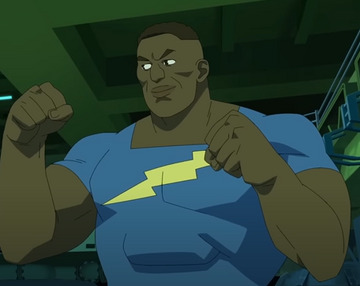
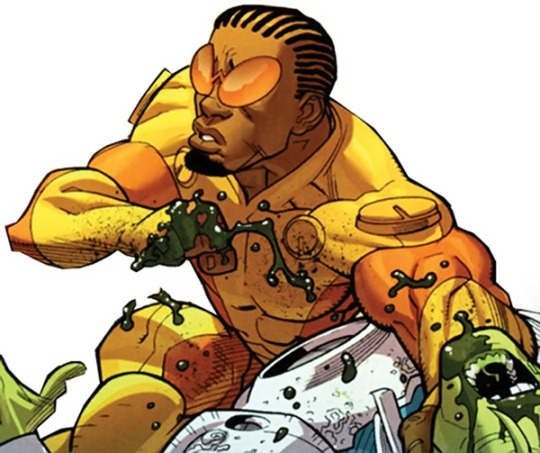

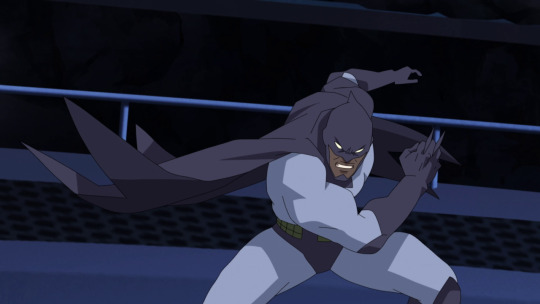
In what ways do costumes and concealing identities further separate the superheroes from normal society? How necessary is it for the superheroes to hide their true identities to successfully achieve their goals?
The show takes some time to explore the process of how superheroes pick their costumes and how they choose to have their identities displayed, such as hiding one of their identities or making attempts to separate them.
A somewhat common trend among some superheroes of the world, usually superheroes who have had experience in the careers or are generally older, is that they don’t wear a mask or any sort of garment that could skewer their identity, which makes a lot of sense for superheroes who don’t have separate identities in their day-to-day lives, but for characters like Omni-man/Nolan Gray and Atom Eve/Samantha Eve Wilkins, one of Mark’s friends and allies, they’re still able to hide and separate their identities without using a mask of some sort. This isn’t quite successful for Eve as Mark is able to recognize her at school after encountering her as her superhero counterpart earlier, and she offers an explanation that most people don’t expect someone they know to be a superhero, a very Hannah Montana situation that mostly works. Mark, however, has a number of reasons as to why he has to wear a mask, especially for the safety of his friends and family, as there are numerous cases in the comics where villains exploit his identity as well as his ties to his Father.
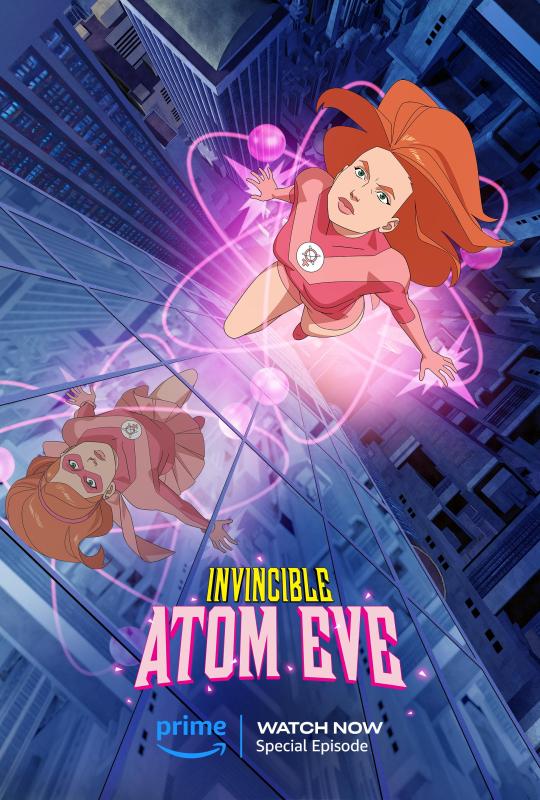
The costume designs also play a part in separating the superheroes from society and are explicitly described as symbols. When he starts, Mark builds his costume with the notable goggles and bandana to hide his identity. He later visits Art Rosenbaum, a suit tailor who designs many of the costumes of the show, and we see him create Invincible’s suit and mask that he dawns for most of his career that helps hide his identity as Mark Grayson (an important detail that will be explored quite soon in the series). When picking a suit design with Art, Mark states that he doesn’t like the orange and yellow suit designs and wants something “more iconic” (hence the yellow ‘I’ in the middle of his suit). This reflects both Mark’s understanding of the superhero identity that is modeled greatly after his father who dawns an ‘iconic’ white and red suit with the letter ‘O’ on it, a symbol, as Omni-man describes it, and the design of other superheroes entities of the time that dawned sleek black lines and colors that accompanied whatever other color scheme the superhero wore.
youtube
How do the economic, political, and social events that occurred during the series’ creation and broadcast cultivate and inform the superheroes’ decisions and actions?
The Invincible comics began its run in 2003, meaning some of the comic elements and stories may have been influenced by the period of time in which there was a heavy focus on the United States combatting terrorism following the events of 9/11, as many “alien threats” dealt with by the superheroes resemble this period. Sam Raimi’s Spider-Man (2002) also came out a year prior and is heralded as a large influence in comic book superheroes, most likely also being an influence in the creation of Invincible as they share very many similar elements (and even have various comic runs where both characters crossover to work alongside each other and are drawn by the same artist).
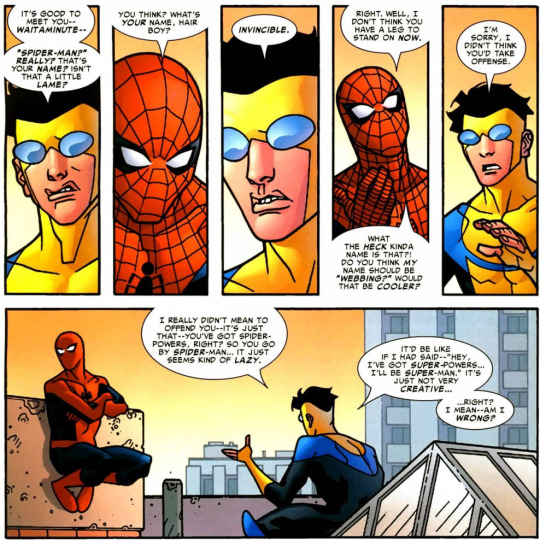
Nonetheless, the T.V. show that’s been broadcasting since 2021 very much attempts to modernize the story, and we see elements of more transparent Government involvement (or rather more exposure into the credibility of the Government) following major events such as Trump’s impeachment. Additionally, in recent years there has been general dialogue and questioning over the State following more and more largely broadcasted and empowering social justice movements and mass protests in recent years (e.g. the Black Lives Matter movement) that have worked to counter a lot of authoritative policies as well as deconstruct prevailing social constructs. In the show, this can be reflected by how Invincible (and several superhero characters) begins to make more of his own decisions instead of simply following orders given to him by Cecil, as well as a general distrust for Government authorities by the general public due to either their reliance on Superheroes and their continuous exploitation of people, both superheroes and non-superheroes.
How do the superheroes question themselves, each other, and their obligations and duties to the people around them?
Mark especially questions his role and obligation as Invincible as his plate grows larger, takes on more responsibilities and constantly has his beliefs toyed with. Growing up with a father as a superhero, being a superhero just like him had been Mark’s dream for 17 years. However, after having his whole world shattered when his father revealed himself to be a world conqueror playing “superhero” and “family man” as a means to accomplish his goal of conquering Earth, killing the most powerful superheroes and thousands of civilians due to Mark refusing to join in the conquest, Mark begins the continuous journey of questioning his role and responsibility as a superhero, often fearing he would turn out like his father and constantly blames himself for the destruction Omni-man/Nolan caused. Even in the second episode, we see Invincible learn the nuances and difficulties of superhero work when he causes the death of an Old lady while trying to evacuate her from an alien invasion.
youtube
youtube
A common theme in the show is the irony of Mark’s superhero name, Invincible, and how he is often going up against threats that are a lot more powerful than him and he repeatedly gets beat up and loses his battles. This takes a toll on Mark, causing him to question his abilities more often than not, as well as those close to him e.g. his mother. It also plays into the theme of growing up and independence and all the challenges that come along with it.
youtube
Atom Eve also goes through her own journey of establishing her obligation and duties as a superhero, as she comes to the realization that her abilities (the power to see and manipulate matter at subatomic levels) could be used for more humanitarian purposes like solving world hunger and building homes rather than being reduced to violence in the form of crime fighting. She leaves her superhero team in order to pursue this goal, which she learns comes with its own challenges that cause her to question whether or not she’s doing the right thing.
youtube
Our season 1 antagonist, Omni-man, has his own journey of questioning himself and his obligation as a superhero. Initially, his militaristic, planet-conquest mindset that is instilled in Viltrumite culture is conflicted when he comes to Earth and learns about humanity and societies on Earth, developing an obligation to protect the planet, even if he planned to conquer it in the future. Even after revealing his goal was to “breed” a suitor, a.k.a Mark, that could help him on his conquest, he is unable to follow through because he’s overcome with emotion and memories of his time on Earth while nearly killing his son. In the 4th episode of the 2nd season, Omni-man shares a vulnerable moment with Mark/Invincible where he talks about how he doesn’t understand why he cares for and feels obligated to protect a “weak” alien species, why he feels like this should be his purpose instead of the Viltrumite conquest, and why death and the guilt of his actions suddenly begins to weigh on him for the first time in his life. The episode ends with Omni-man fighting his ex-comrades to protect an alien planet alongside his son, completely showing an overhaul in his initial ideologies, and is prepared to die for the Thraxan alien species.

@theuncannyprofessoro
21 notes
·
View notes
Text
How related is the narrative of this show to the original The Boys? Do you think viewers can watch this without having seen the other show and still understand what is happening?
@theuncannyprofessoro
Superhero Roundtable
Gen V (2023)
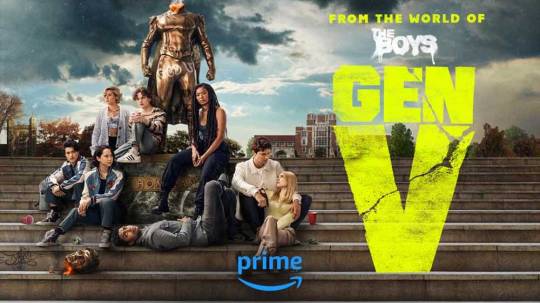
The series Gen V is a spin-off of The Boys series on Prime, it aired very recently with the season only wrapping up on November 3rd of this year. The show takes place in the same universe as The Boys and its timeline is meant to align and intersect a bit with the new season. Instead of focusing on the main adult superheros of the universe, Gen V chooses to center its narrative on the younger victims of compound V (Which is the drug people can take to potentially get powers). The show is set in a college that only ‘Supes’ can attend (think Sky High). There they are ranked and all aim for the number one spot and to be a part of the famous ‘7’ supe group. The show is similar to what I talked about in my Buffy roundtable but here demons are swapped with superpowers for adolescent woes metaphors.
How do structural mythology, cultural studies, and cultural history reflect the series?
As the show came out this year it's cultural studies and history is all very recent, and it specifically caters toward Gen Z. In doing so the cast is much more diverse than The Boys and earlier superhero shows. The main character is a young Black woman named Marie who’s love interest is a bigender Korean American who can shapeshift between two different genders of masculine and feminine. The friend group she also meets up with also consists of others diverse in background and ethnicity. The call for more diverse superheroes is definitely a product of more recent cultural values and changes, especially with younger people being the target demographic. The politics of the show also represent the recent political timeline with our generation's disappointment in the actions and lack of actions the government has taken on corruption with capitalism, climate change, etc . This can be seen with Vought International, the multibillion dollar conglomerate that founded the famous 7 and manages ‘supes’. The company also does entertainment, news, weapons, fast food chains etc. The corruption of the company and its supes, most notably its most powerful supe Homelander who’s villain arc mirrors Trump, really fits the current post Trump political climate. The structural mythology of supes in the show is interesting as well. Instead of the show having the classic Hero’s journey with its superheroes and their gaining of powers. The main characters of the show got their powers from their parents injecting them with Compund V so they could profit off of their abilities. The superpowers they have are often the root of their trauma. The main character, Marie, has blood controlling powers that manifested on her first period and led her to accidentally kill her parents in front of her sister. Overall, this pessimistic view of superheroes and their powers is really reflective of our current political and cultural landscape.
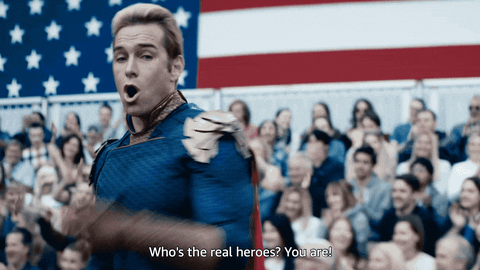
In what ways are the superheroes and their abilities informed by their racial, gender, sexual, and cultural identities?
One superhero that exemplifies the concept of their abilities being informed by their identities—specifically gender—is Jordan Li, the bigender Korean American who can shapeshift between two different genders of masculine and feminine that I previously mentioned. Through Jordan Li’s super powers the show is able to mythologize gender fluidity and identity struggles. In this clip, Jordan is talking to their parents who are upset that their developing powers gave them the ability to shift from a boy to a girl. Jordan has to explain that they are still themselves in both forms and have always been the same, but their father still disapproves.

In what ways do costumes and concealing identities further separate the superheroes from normal society? How necessary is it for the superheroes to hide their true identities to successfully achieve their goals?
In the Gen V the superheroes identities aren’t concealed from the public but they do have superhero personas that they are more known by in the public and media sphere. The celebrity-like status they have with their super personas is used to other them and commodify their powers to entertain others as a spectacle. One example of this is with the character Emma whose superpower is her ability to make herself change size. At school she is majoring in becoming a super influencer basically and goes by the persona ‘Little Cricket’ for her popular youtube channel. While her channel is popular we learn that it really is her mother wanting to profit off of her abilities and doesn’t care that she has to throw up and purge in order to change herself. Her power is also fetishized by a male classmate who wants her to get small while they are intimate. So in Gen V the creation of separate identities is not used to achieve their own personal goals but is instead taken advantage of by non-supes to capitalize off of.
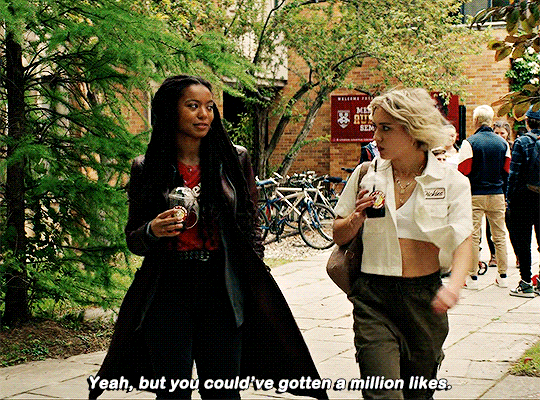
How do the economic, political, and social events that occurred during the series’ creation and broadcast cultivate and inform the superheroes’ decisions and actions?
In the series there is a very ‘us vs. them’ mentality between the supes and non-supes that is reminiscent of the current political climate. In episode 7 a senator comes to the school for an interview and it ends in a riot. The senator runs the Federal Bureau of Superhuman Affairs which seeks to monitor and investigate Supes and stop them from harming others. In the panel Senator Neuman is trying to pander to both sides, with boos and applause for each statement as the students are split between wanting to punish Supes like Homelander for killing innocent people or for thinking that not supporting him is Anti-super. As the episode description shows,
Calling all God U #Hometeamers! Today we’re protesting Socialist Victoria Neuman’s town hall on campus! Let’s show Neuman and her Supe-hating woke mob that we won’t put up with their anti-Superhero agenda! THEY WILL NOT CONTROL US! #MakeAmericaSuperAgain #SupeLivesMatter
The supe vs non-supe divide is very politicized with it mirroring liberal and conservative ideals of the spectrum. The situation is very polarizing and the “Supelivesmatter” crowd ends up disrupting the panel and it becomes very violent. The show is not very subtle with its mirroring of Blue Lives Matter and MAGA, especially with Homelander being a stand in for Trump. This is the central conflict between America’s general super population and their actions demonstrating the impact of our own political news cycle on the show.

How do the superheroes question themselves, each other, and their obligations and duties to the people around them?
In the show characters are constantly questioning intentions, who to trust, and what is right and wrong–especially within the supes and non supes dichotomy. The main characters are grappling with if the pain and violence that their powers have inflicted on others unintentionally are actually their fault and dealing with their guilt and self hatred for it at the same time.

This really leads to the central conflict of if their obligations are to use their powers to protect themselves or the non-supes that put them in the position of having these powers in the first place. The show is really complex in its portrayal of this as in the final scene of the show you are really left wondering what is the right thing to do alongside the characters as they decide who they should side with. Gen V is unique because while in The Boys the superheroes are more villainized but in Gen V it’s more unclear as we are able to see through following the adolescent super perspective it wasn't their fault. It is only at university that Marie and other students are able to begin to realize that the violence and trauma their powers have inflicted on their families and other non-supes is not their own but their parents' fault for injecting them with compound V in the first place.

The fact that their parents did in want of fame and fortune promised by Vought International, really shows that capitalism has been the real villain all along.
“Your parents shot you up with a dangerous drսg when you were a baby to make a buck off you. Don't spend a fսcking minute crying over them”


@theuncannyprofessoro
17 notes
·
View notes
Text
Do the people without quirks resent the people who have powers? What is that relationship dynamic like?
@theuncannyprofessoro
Roundtable Presentation: My Hero Academia

How do structural mythology, cultural studies, and cultural history reflect the series’ world and world-building around superheroes?
My Hero Academia draws heavy influence from Western Superhero comics. The character designs themselves as well as the hero society that is built up reflects a lot of aspects specifically shown in Marvel and DC. My Hero also takes the classic Hero’s Journey mythology concept and portrays this the the main character Izuku Midoriya. He goes from being quirkiness, to inheriting one the most powerful quirks and becoming a hero.
In what ways are the superheroes and their abilities informed by their racial, gender, sexual, and cultural identities?
In My Hero Academia, the characters manifest quirks in a way that is usually completely unique to them. A lot of the times, quirks are influenced by genetic factors with characters usually manifesting a quirk that is similar to a combination of their parents quirk. They are similar to how certain traits are inherited in the real world. A lot of diversity is also shown through the costumes that heroes design for themselves. These designs can incorporate different cultural or personal elements that allow for characters to better express their individuality. for the most part quirks are not determined by racial identity, gender and sexuality.

In what ways do costumes and concealing identities further separate the superheroes from normal society? How necessary is it for the superheroes to hide their true identities to successfully achieve their goals?
In My Hero Academia, there is a whole society of heroes. It takes place in a world where 80% of humans suddenly begin to develop superpowers. Heroes are separated from society in the sense that they are looked up to and depended on by many people with weaker quirks. Being a hero is oftentimes a job that is sought after, with whole schools dedicated to teaching young students to be good heroes. Finding the right costume is important for every heroes journey, usually made to enhance their specific quirk and be recognizable and marketable. It’s not necessary for professional heroes to hide their true identities. Most of the time, being a hero is something to show off especially if you are ranked in the top ten. However, heroes do have a separation when they are on the job vs when they are off. I’ve noticed a trend in the show where older, more established heroes turn on a heroic personality when they are on the job but are completely different in their personal life.
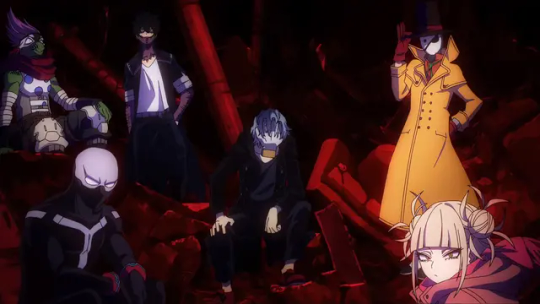
How do the economic, political, and social events that occurred during the series’ creation and broadcast cultivate and inform the superheroes’ decisions and actions?
The emergence of Quirks in the My Hero Academia has social implications especially highlighted in the discrimination and prejudice against those with "villainous" or "unusual" Quirks. This mirrors societal attitudes toward individuals who are perceived as different or other. While the show is not heavily influenced by real life events, a lot of the characters are based on or inspired by classic comic book characters and manga characters.
How do the superheroes question themselves, each other, and their obligations and duties to the people around them?
Many of the older heroes in the show often question themselves and their motives. A few seasons into the show, the viewers start to see that heroes aren’t always good and the hero society is responsible for forcing people into the role as villains. There is also an arc of the show where its’ hard for the characters to trust each other because of double crossing and undercover work. The younger heroes in training seem to have a more optimistic view on being a hero because they are new to the business. Because being a hero isn’t some big secret, those with strong quirks and hero training can jump into action at any point with no worries about being caught.

@theuncannyprofessoro
13 notes
·
View notes
Text
Was the show aimed towards a younger audience that would watch cartoons or an older audience like the gen x influence you described?
@theuncannyprofessoro
The Venture Bros.
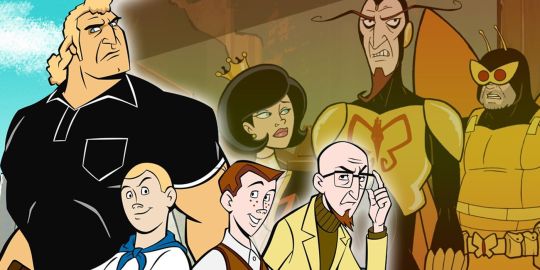
The Venture Bros. takes many assumptions from the Golden and Silver Age of comics and comments on them. It parodies certain elements of comic book history, including ‘the boy adventurer’ (Jonny Quest) trope and space-age fiction themes and aesthetics. The series follows Dr. Thaddeus “Rusty” Venture, a sad failure of a Super Scientist living in the shadow of his late larger-than-life father, Dr. Jonas Venture. Rusty is a superhero in title but not in practice, yet he still has a rotating cast of villains and sidekicks around him. His arch nemesis is a villain called The Monarch, who I focus on for this piece. I think Rusty represents the more cynical, morally ambiguous Silver age of comics while his father represents the authoritarian Golden age, to put it into Williams’ framework from “(R)Evolution of the Television Superhero”. The Venture Bros contributes to a misanthropic view of superhero narratives. All of the characters have major flaws directly connected to their association with Super Heroism and its flipside, Super Villainy. Changes in values over time are shown in the narrative through flashbacks and convoluted storylines involving many characters over several seasons. Overall, though, the series pokes fun and levies criticism against prevalent superhero notions.
The Monarch, Dr. Venture’s Arch Nemesis, is a scrawny, goateed, middle-aged white male who has made a career out of being evil. In some ways, he is very successful, with an awesome spaceship headquarters, a team of devoted henchmen, and a sexy villainess girlfriend. However, the Monarch is shown to oscillate between overconfident and insecure, as seeking validation, and as unable to thwart his self-proclaimed nemesis, no matter how many opportunities he gets.

The Monarch represents an attitude of dissatisfaction among men who actually have quite a bit going for them. I feel like this reflects a culture of misplaced victimhood held by some men as the liberation of women and other oppressed groups makes them feel like they are losing some kind of power or status.
The Venture Bros. is all about funny costumes and character design. The Monarch has leaned all the way into his butterfly-and-insect-themed villainy. His costume is an integral part of his character, and he is rarely seen without it.
His voice and mannerisms are enough to make the Monarch recognizable even when he is not in costume, but he derives much of his power from his outfit, the consistent theme of his evil operation, and his flashy technology. The Monarch has a hard time performing villainy when not in costume. In this universe, Villany is a career, and the job requires a uniform.
The show is definitely influenced by 9/11 and the entrance of Gen Xers into the media scene. The show debuted in 2003, when the Cold War Kids (not the band) were finally entering the workforce and the public eye and expressing their feelings and attitudes about social and political realities of the time. The Monarch is an expression of social, economic and political disillusionment that can go in divergent directions and lead to extremism. Venture represents apathy and adherence to established systems, despite their idiocy.
In Season 1 Episode 5 of the Venture Bros., the viewer gets a glimpse into the more neighborly side of superheroes and supervillains as they are introduced to members of The Guild of Calamitous Intent when Venture hosts a yard sale at his compound and invites all the Villains he works against, with the understanding that no harm can come to him because it is not guild-approved and therefore the villains have no legs to stand on in terms of evil. Even so, the Monarch, Dr. Venture’s sworn enemy, wreaks non-approved havok at the yard sale. In search of a suitable bathroom, Monarch and Dr. Girlfriend walk through the compound and see the sad emptiness of Dr. Venture’s life. For a moment it seems the Monarch has a realization about his Villainy and almost gives up “Arching” Dr. Venture, but when the security team gives him a fright, the Monarch vows to destroy Dr. Venture and reconstitute the Nemesis status.
I think this faltering of ideology that the Monarch experiences shows how perceived obligations are subject to change situationally. This applies to foreign relations because attitudes about domestic policy, domestic views on other countries, and also relationships between nations and states are products of history but also are fluid.
@theuncannyprofessoro
21 notes
·
View notes
Text
Do you think this new direction of superhero narratives will catch on and become the new norm for this genre of film and television?
@theuncannyprofessoro
We Don't Need Another Superhero: The Boys (2018)
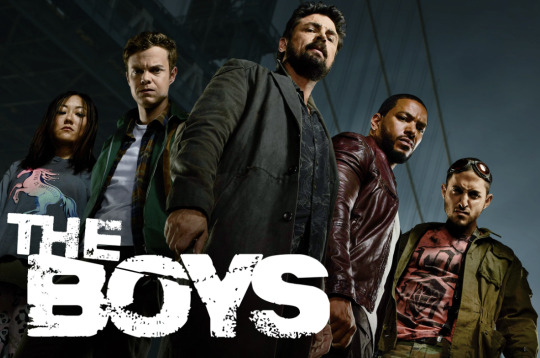
William’s assertion that TV Superheroes symbolize our ever changing “American values” is proven true by The Boys’ (2019) critical reflection of the our 21st century nation’s hierarchical distribution of economic, social, & political power, aggressive foreign policy/patriotism post 9/11, and represents the (much needed) beginnings of progressiveness through its rebellious protagonists. The show surrounds Starlight, the newest member of the Seven (America’s favorite Superheroes/“Supes” managed by Vought, an antagonistic, all-controlling company), who, after being assaulted by her childhood idol on the first night, quickly learns that the group’s heroic image is “written by the marketers.” She teams up with Hugh–our human protagonist whose fiance was murdered by a Supe–and his gang of similarly wronged (and vengeful) misfits to destroy the Seven, and eventually, Vought. The narrative frames Superheroes as the actual villains; Williams states that “with great power comes great responsibility,” but in the Boys’ speculative America, this statement is pretty unfortunate.
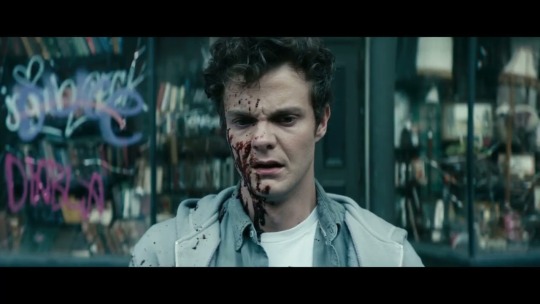
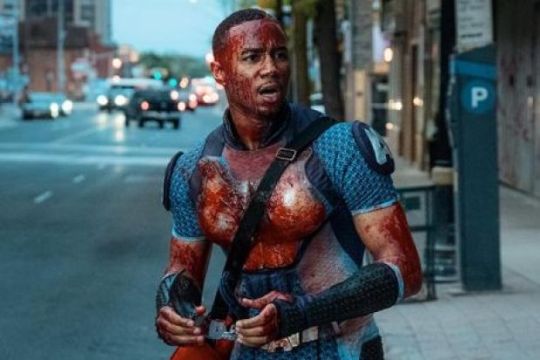
How do structural mythology, cultural studies, and cultural history reflect the series’ world and world-building around superheroes?
The Boys contradicts mythos of the intrinsically good Superhero by exploring the hierarchical, power-based, hegemonic underground world of the Supes, who are closer to flawed–rather than superior–humans. Homelander’s hatred of humans and the Deep’s array of sexual assaults contrasts with their publicly perfect (mythos-based) personas. In terms of cultural studies, the international influence of Vought and its Supes mirrors our unjust attribution of social power. Ezekiel–an antagonist Supe whose homophobic Catholicism contrasts with his secret homosexuality; S1 depicts him angelically floating above crowded young fans while preaching. His sex & drug-filled life is hidden from the naive public, reminding us to question the ideology presented by God-like figures in contemporary society. Superheroes’ mode of “action and conflict” is brutal, gory, in line with 21st century’s chaotic foreign policy. Well described its international standpoint as “America the Violent,” The Boys opens with A-Train literally running through Hugh’s fiance on the street, leaving the bloody protagonist to hold his girlfriend’s (cut-off) hands (the Nation, 2023). If that’s not enough, Homelander kills humans for fun. His destruction mirrors Trump’s reign–“critics say President Trump’s foreign policy has seriously undermined America’s world leadership” (the Hill). Luckily, the fight for progressiveness is represented by both Supes and humans.

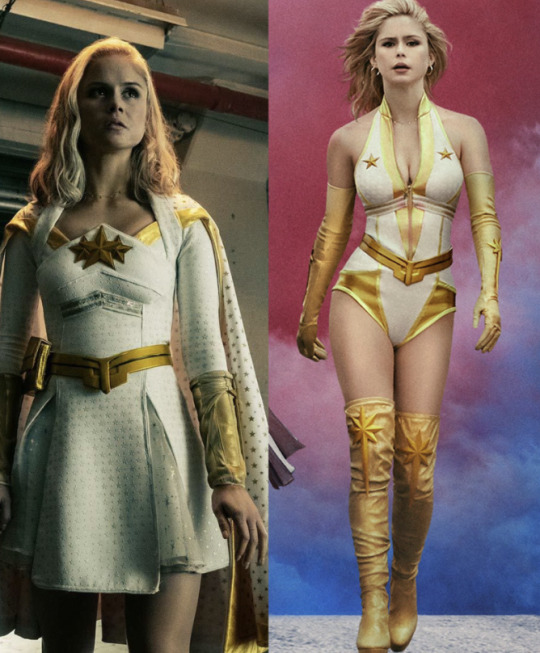
In what ways are the superheroes and their abilities informed by their racial, gender, sexual, and cultural identities?
Despite Vought’s public diversity, their performativity is evident in the structural, identity-related barriers that hinder all members of the Seven (except Homelander, whose straight white identity is, uncoincidentally, the face of America). Homelander’s role in Vought’s decisions (and national power) contrasts with the company’s disregard of A-Train, a Black member of the Seven. His requests–such as an apology from Superhero Blue Hawk (a stereotyping racist who curb-stomped a Black man)--are typically ignored despite his sudden importance for #BLM marketing. Still, A-Train eventually kills Blue Hawk, framing him as stronger than the white, hegemonic structure that attempts to define him. Starlight’s entrance into the celebrity-Superhero world illustrates the struggle of gender; soon after signing her, Vought changes Starlight’s modest costume to a skimpy bikini, threatening to fire her if she doesn’t cooperate. The following scene depicts her in the bikini, men yelling to “show her boobs” in front of her young, innocent fans; gendered sexualization is framed as a barrier, overshadowing her identity as a strong Superhero. Maeve’s bisexuality sheds light on the heteronormativity of the Supe system; after years of hiding her bisexuality, heteronormative Homelander finds out and publicly outs her (in angry jealousy) as a lesbian. Vought’s binary view of sexuality results in their manipulation of this outing as a way to ‘diversify’ and profit–Maeve is marketed as the new face of lesbianism, illustrating her difficulty presenting her true Superhero identity in this binary system. Kimiko–a victim of human trafficking–illustrates intersectionality as female, Japanese, and Super; her cultural difference from the show’s world is evident throughout Season 1, when the boys attempt to ‘figure her out,’ somewhat like an unknown concept. Kimiko’s empowerment in later seasons indicates her contradiction of the hysterical, alien “Female,” and rather frames intersectionality as part of her uniquely heightened strength.
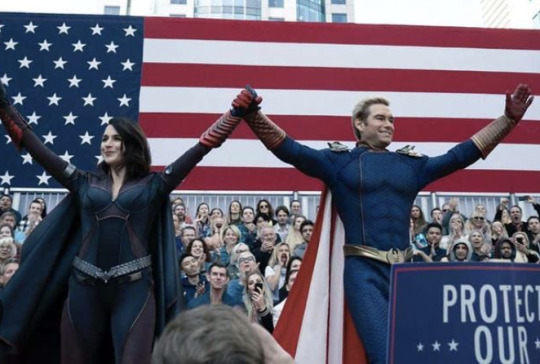
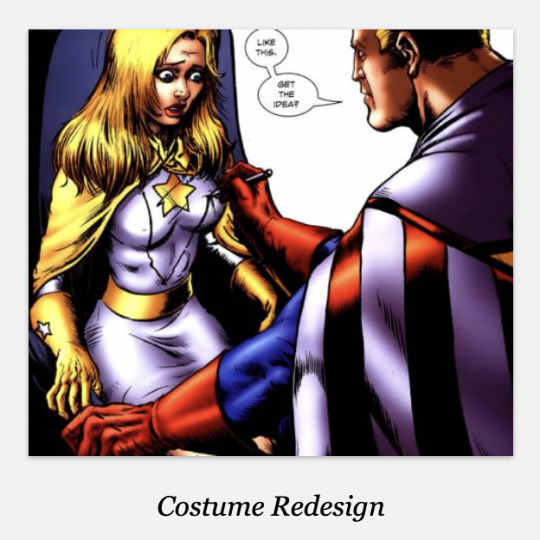
In what ways do costumes and concealing identities further separate the superheroes from normal society? How necessary is it for the superheroes to hide their true identities to successfully achieve their goals?
Costume reflects the humanity (or lack thereof) of Superheroes; Homelander is never shown without his costume on, which alludes to his lack of humanity and hatred of non-Supes. The costume represents his “real” persona while his humanity is “the facade” (1344). His “true,” villainous identity must thus be hidden in order to win the public’s affection and achieve his power-hungry goals. On the other hand, Starlight avoids costume and is framed as the most human Supe. In the first few episodes, we learn about her background through moments with Annie–her real name–while she sits at the bar, bowls, or walks through the park in ‘normal’ clothes. Still, she must hide her true identity to satisfy Vought’s hegemonic idea of success. Kimiko is never seen in costume, and is framed as the sweetest and purest Supe despite her introduction as the most alien. Her lack of interaction with the roles created by Vought (and the costumes that realize them) results in her formation of a singular identity rather than a “super” vs “normal” self like the Seven, and quickly settles into her Superhero strength.
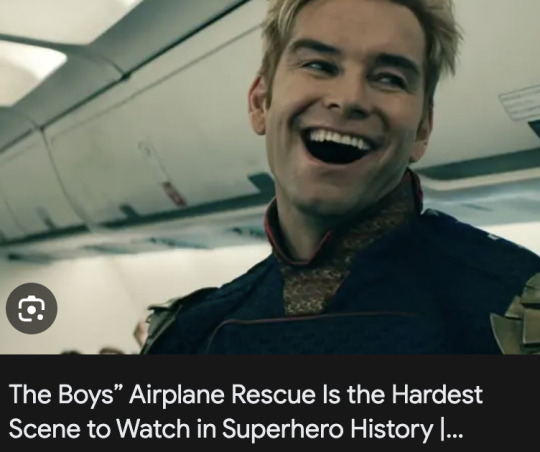
How do the economic, political, and social events that occurred during the series’ creation and broadcast cultivate and inform the superheroes’ decisions and actions?
Superheroes’ paths are informed by economic (human trafficking), social (#MeToo, BLM), and political (terrorism, 9/11) events. Kimiko–a Japanese trafficking victim–fell into a vat of Compound V (Vought’s superhero serum) and gained unusually intense Super-strength. The economic value placed on her extreme strength results in her imprisonment as a lab rat and trafficking into the U.S. Her origin story addresses the nation’s concerning economic flow from human trafficking, pictured in relation to Compound V through Vought’s transnational trade. The #MeToo social movement affects Starlight after her sexual assault in by the Deep, a member of the Seven (E1). While the shows creators considered “behind-the-scenes” revenge narrative, they constructed Starlight’s public revenge with references to #MeToo after the movement’s coincidentally timed real-world emergence; the historical social movement shaped Starlight’s story (the Nation). “Flight 37”--a crashed plane hijacked by terrorists–is likely a political reference to 9/11. When Homelander tries–but fails–to save the plane, he simply leaves everyone to die and pretends he was never there. When the tragedy goes public, he expresses his sorrow through fake tears and a politically oriented speech; he demands the American need for real protection, specifically, Supes in the military. Homelander’s manipulation of a national tragedy to assist his right-wing agenda mirrors 21st century politics under Trump’s guidance.

How do the superheroes question themselves, each other, and their obligations and duties to the people around them?
Stan Edgar (a Vought executive) leads Homelander to question his own capability despite the Supe’s undefeated physical superiority. Edgar’s statement that Homelander is “not a God,” but “simply… bad product” results in Homelander’s atypically poor performance in a fight with Soldier Boy in the following scene (S3, the most important fight of the show). The physical manifestation of Homelander’s insecurity sheds a rare light on his humanity. His creation of an abusive workplace environment means that none of the Supes trust him, especially Maeve, as their past/media-friendly romance gives her more insight than the others. She consistently questions his intentions and thus keeps a poker face, smiling to avoid his (physically threatening) temper; her distrust shows as soon as Homelander leaves and a hidden fear replaces her fake smile. Starlight similarly distrusts and questions her obligation to remain in the Seven, and only stays to please her selfish mother. The eventual discovery that her mother selfishly injected baby Starlight with Compound V dissolves the Supe’s trust of and obligation to her mom; Starlight remains in the Seven, but for moral, personally driven reasons.
@theuncannyprofessoro #oxyspeculativetv
17 notes
·
View notes
Text
If you watched this as a kid and again recently, was there anything that stuck out that you never realized as a kid?
@theuncannyprofessoro
The Powerpuff Girls

How do structural mythology, cultural studies, and cultural history reflect the series’ world and world-building around superheroes?
The Powerpuff Girls constructs its world through a combination of structural mythology, cultural studies, and cultural history. Structurally, the series adheres to the superhero genre's conventions with the trio of Blossom, Bubbles, and Buttercup representing archetypal hero figures. The cultural studies lens is evident in the show's exploration of diverse characters and themes, challenging traditional gender norms by featuring female protagonists with distinct personalities. Cultural history manifests in the series' context, reflecting the late 1990s and early 2000s ethos, contributing to the development of the Powerpuff Girls' characters, their challenges, and the dynamics within their fictional world.
In what ways are the superheroes and their abilities informed by their racial, gender, sexual, and cultural identities?
The Powerpuff Girls challenges gender norms by portraying the superheroes as three powerful and capable girls, transcending traditional gender roles in the superhero genre. However, the series does not explicitly delve into racial, sexual, or cultural identities. Instead, the characters' abilities and identities are more broadly representative, emphasizing universal themes of empowerment and teamwork, thereby fostering inclusivity. The focus is on their superhero roles rather than specific identity markers, aligning with the series' commitment to a diverse and inclusive narrative.
In what ways do costumes and concealing identities further separate the superheroes from normal society? How necessary is it for the superheroes to hide their true identities to successfully achieve their goals?
Costumes and concealed identities in The Powerpuff Girls serve to separate the superheroes from normal society by creating a distinct superhero persona. Despite their childlike bodies, the girls don't wear masks like the typical superheros, but their costumes signify their superheroic roles. The necessity of hiding their true identities is tied to protecting their personal lives and maintaining a sense of normalcy within the context of their youthful appearances. By concealing their identities, the Powerpuff Girls can navigate both the challenges of superheroism and the mundane aspects of their lives without undue interference or scrutiny. The juxtaposition of their childlike appearance with their superhero responsibilities adds an additional layer of complexity to the need for identity concealment.
How do the economic, political, and social events that occurred during the series’ creation and broadcast cultivate and inform the superheroes’ decisions and actions?
Drawing insights from Kevin D. Williams's article, which explores how superhero narratives reflect societal changes, we can apply this framework to The Powerpuff Girls. The late 1990s and early 2000s, when the series was created and broadcast, were marked by significant cultural shifts. The show aligns with broader societal trends of the time, emphasizing themes of empowerment and diversity, which are likely influenced by the cultural climate of that era. For instance, the late 1990s witnessed a growing awareness of gender equality, and the Powerpuff Girls, as female superheroes, may be seen as a response to or reflection of this cultural shift. The series captures the zeitgeist of the late 20th century and early 21st century, with its characters embodying the values and aspirations of the period.
How do the superheroes question themselves, each other, and their obligations and duties to the people around them?
The series engage in self-reflection and questioning throughout the series. Despite their superpowers, they grapple with typical challenges of growing up, forming their identities, and understanding their roles as superheroes. The dynamics between the sisters involve questioning and occasional conflicts, reflecting the complexities of sibling relationships. The superheroes' obligations and duties to the people around them are generally portrayed positively, with the girls embracing their roles as protectors of their city, but occasional moments of doubt or internal conflict contribute to their character development and the overall narrative.
17 notes
·
View notes
Text
How do you think the show would differ if it was American made rather than Japanese made?
@theuncannyprofessoro
The Disastrous Life of Saiki K. - Superhero Roundtable

How do structural mythology, cultural studies, and cultural history reflect the series’ world and world-building around superheroes?
The Disastrous Life of Saiki K centers on the titular character, Saiki K, a highschool student with Superman-esque levels of psychic power. He has trademark pink hair and must wear green glasses and antennae in order to limit his powers. Saiki, as one of the only actual psychic characters in the anime, actually doesn’t want to solve problems, or help anyone with his powers, and most of the show he uses his powers to minimize attention and keep to himself. His only really widespread use of power was changing everyone in the world’s hair color to also be colorful so that he doesn’t stand out as much. In direct opposition to Saiki’s nonexistent need for attention and immense psychic power, his classmate Kaidou, has no power whatever but claims to be The Jet-Black Wings, the only person standing against The Dark Reunion, an evil organization running the world behind the scenes. This is played for satire as Kaidou loudly brags about being the Jet-Black Wings and blames every mishap on the Dark Reunion, wears red bandages on his arms to “control his power,” and a dramatic action song “Judgement Knights of Thunder” plays everytime he does anything.
youtube
Saiki K is a comedy anime satirizing the idea of a “superhero” through Saiki K, who kind of sucks and doesn’t care that much about other people, but even in using his powers selfishly, ultimately helps the people around him. This show challenges the idea that superheroes would necessarily swing to complete good or complete evil, and makes fun of those ideas in the example of satirizing binary thinking through Kaidou’s fake enemy, The Dark Reunion. Although the show begins with Saiki K doing everything he can to avoid attention and making friends, he warms up to his classmates over the show and uses his powers for their benefit, even as he convinces himself he’s just trying to help himself.
The origination of manga in Japan was influenced by the globalization of American comics, including superhero comics, brought during WWII. Interestingly, as members of the Axis Powers, Japan and Japanese characters were featured in American superhero comics as enemies to the nation, often depicted as racist stereotypes for wartime propaganda. On an international scale, superheroes are associated with the US, as a national export and national representation of American might and power. This can be seen in superhero anime like My Hero Academia, where All Might represents the All-American superhero figure. Shows like Saiki K and Mob Psycho 100 have superhero-like characters and themes but distance themselves from calling them that, positioning themselves as psychics rather than superheroes.
In what ways are the superheroes and their abilities informed by their racial, gender, sexual, and cultural identities?
Saiki K definitely participates in the de-racialization of characters as Will Bridges spoke to in “The Past Tense and the Future Perfect,” which we read for Cowboy Bebop. All of the characters are assumed to be Japanese, and are very homogeneous in appearance, save Nendo, whose butt-chin and weird mohawk are played for laughs. In many ways, Saiki represents the ultimate hegemonic male character who is conventionally attractive, cishet, middle class, and extremely able bodied. The only way that Saiki represents “other” could be through his lack of romantic or sexual interest in the show, much to the chagrin of Kokomi, the self proclaimed queen of the school, who appears with a halo of light around her at all times and has caused multiple stampedes of men chasing after her. The character Kaidou, who isn’t very popular with his classmates (somewhat because he always talks about the Dark Reunion), could be acting out social rejection through his fixation on being a superhero fighting evil, above the social dynamics of highschool.
In what ways do costumes and concealing identities further separate the superheroes from normal society? How necessary is it for the superheroes to hide their true identities to successfully achieve their goals?
For Saiki, hiding his identity is his goal. To this end, he has changed everyone’s hair in the entire world to be colorful so that he doesn’t stand out. When the school has a sports test in gym class, Saiki has to tone down his supernatural speed and strength to blend in, including teleporting a ball back when he throws it so far that it can’t be seen, and squeezing a grip strength monitor so hard that that needle goes all the way around and it looks like he has an average score. For many superheroes, putting on a costume/disguise is necessary to carry out their goals, but for Saiki, his physical appearance is connected to his supernatural abilities, and the antennae and glasses he wears serve not to express his powers or his superhero role, but rather to minimize and control them.
How do the economic, political, and social events that occurred during the series’ creation and broadcast cultivate and inform the superheroes’ decisions and actions?
The Disastrous Life of Saiki K first appeared as one-shot manga chapters published from 2012-2011, then serialized in Weekly Shonen Jump from 2012-2018. The anime based off of this manga was aired from 2016-2018. I think Saiki K intentionally builds off of the context of preexisting superhero media to satirize it, questioning the characterization of other characters with superpowers as good and selfless or evil and self-serving- Saiki is literally just some guy and he doesn’t feel any pressure to use his powers for anyone. The anime creates a depoliticized superhero- he isn’t connected to any hero organizations or governments, he doesn’t have any enemies. He is so depoliticized and inactive as a superhero figure that his morals swing all the way around into questionable because he is so powerful, and could solve so many problems, but only changed everyone’s hair.
How do the superheroes question themselves, each other, and their obligations and duties to the people around them?
Saiki K as a show challenges the superhero trope of questioning their purpose, sense of self and obligation to others by making Saiki antisocial and feel pretty neutrally about everyone besides himself. He always ends up helping the people around him, even when he doesn’t mean to, often doing so because it’s the easiest way to avoid being exposed, or not taking action will negatively impact him in some way. In one episode, he watches a magician on TV being locked in a box, and when it seems like he won’t be able to escape in time, Saiki teleports onto the set to save him. He does this in order to save the magician from a deadly incident which could potentially delay the rest of the tv channel, including Saiki’s favorite mystery show that after the magic show. He does help people, but his obligation is (allegedly) to himself first.
@theuncannyprofessoro
21 notes
·
View notes
Text
How does the sibling dynamic play out in the show?
@theuncannyprofessoro
The Umbrella Academy- We Don't Need More Superheroes

The Umbrella Academy (2019) is a show that follows a group of adopted siblings, each with their own power, and their journey to solve the mystery of their father’s death and save the world from an impending apocalypse.
How do structural mythology, cultural studies, and cultural history reflect the series’ world and world-building around superheroes?
The Umbrella Academy is set in present day (2019) yet plays around with time and timelines throughout the narrative, as one of the siblings Five has the ability to manipulate time. As for structural mythology, the show is based on the books, yet as a viewer who is unfamiliar with the original content, I would say the show is definitely set up in a mystery, as we are introduced to the siblings in the first episode, yet are constantly in the dark when it comes to the reasoning behind the 43 births and what caused it. Though the narrative setup of the death of guardian/father figure, Dr. Reginald Hargreeves, brings the siblings together to mourn his death, Hargreeves is still shrouded in mystery. What is appealing about Umbrella Academy is the diversity of the siblings themselves, and how they go through their own individual experiences dealing with their powers and how they come together to try and stop the impending apocalypse and save the world. As for cultural history, the show does include many significant moments of history, as many scenes take place in the past due to the constant time warping in the show. For example, the Vietnam War, Civil Rights Movement and even the assassination of JFK are all a part of the show, and each siblings’ experiences in the “past” have a direct impact on their own journeys and also their future.
In what ways are the superheroes and their abilities informed by their racial, gender, sexual, and cultural identities?
To my knowledge there is not necessarily connections between the siblings' abilities and their racial/gender/sexual/cultural identities. But, there are definitely ties between each siblings' emotions and their abilities, especially when it comes to sibling 7 Viktor. At the beginning of the series, Viktor is known as the sibling without any powers, and is ridiculed and ignored by Hargreeves as a result. Viktor sees himself as useless compared to his siblings, but it is later revealed that Hargreeves used pills to suppress Viktor's powers of manipulating sound into physical force because he deemed them to be too dangerous. Viktor unlocks these powers after not taking the pills anymore, and releases his full potential, but struggles to control his powers.
In what ways do costumes and concealing identities further separate the superheroes from normal society? How necessary is it for the superheroes to hide their true identities to successfully achieve their goals?
When the Umbrella Academy is younger and growing up under the tutelage of Hargreeves there is a specific uniform the children wears, which features a school-like red and gray uniform and the iconic and traditional superhero mask. I think most of the difficulties when it comes to the siblings lives is that they each have their own desires aside from their constant missions and family drama. As they encounter different experiences in different timelines, the siblings find love, careers they care about, and other things that are separate from being superheroes.

How do the economic, political, and social events that occurred during the series’ creation and broadcast cultivate and inform the superheroes’ decisions and actions?
In Kevin D. Williams’s “(R)Evolution of the Television Superhero: Comparing Superfriends and Justice League in Terms of Foreign Relations" Williams discusses how many political events and ideologies have a direct impact on the narratives and ideologies of superheroes, specifically with political climate post Cold War and post 9/11. The second season of "The Umbrella Academy" takes place mostly in the 1960s, as at the end of season 1, sibling Five saved all his siblings by taking them to the past, and they are now scattered and each experiencing their individual lives in the 60s. This places all the siblings during Cold War era US, and the narrative specifically forms around JFK's assassination and the Civil Rights Movement, which specifically impacts Allison the most. Allison becomes an active member of the Civil Rights Movement and describes her motivation and empowerment to exist outside her scope of superhero powers, which involve manipulation. I think it is interesting that the show includes the self-doubting aspect of being "super" in some ways because I think it helps make the characters feel more authentic if they're concerned how their powers impact themselves as humans. In season 2, Allison participates in a sit-in at a whites only diner and uses her powers to manipulate a police officer to stop beating her husband Ray. This causes him to run away from her because he is afraid, but the two later reconnect.
How do the superheroes question themselves, each other, and their obligations and duties to the people around them?
Because the main superheroes are siblings, it makes for a really interesting dynamic to watch onscreen. Not only are they a family, but an estranged one that has just been reunited due to the death of their father. Of course they act just like any siblings and question themselves and each other. Because Hargreeves literally numbered them off based on their "usefulness" to him (#1-7) their childhoods were definitely not normal in the sense that he was raising them to serve him. Especially for Viktor, their childhood was extremely traumatizing and his history with certain siblings even causes fights and tension in the present timeline. During one episode, it is revealed Hargreeves instructed Allison to use her powers to manipulate Viktor into forgetting that he had powers. This relevation causes Viktor to lash out at Allison, which speaks to how the siblings' turbulent history still has impacts on their current relationships with each other.
@theuncannyprofessoro
18 notes
·
View notes
Text
This show is highly regarded and the highest rated marvel tv show. It seems very different from their usual narratives, so what do you think made it so successful?
@theuncannyprofessoro
Roundtable Presentation: Ms. Marvel

How do structural mythology, cultural studies, and cultural history reflect the series’ world and world-building around superheroes?
In the series Ms. Marvel, Kamala is a high school girl who one day acquires energy-based powers. The source of her powers comes from a bangle inherited from her grandmother who disappeared during the Partition of India. This bangle Kamala discovers in a box of her grandmother's belongings is later known to be a quantum band, that before this was only known to be heard of in myths and legends. This historical and mythological premise of the show dictates the origin of Kamala's powers and her path of discovery and growth as she develops and better understands her powers.

In what ways are the superheroes and their abilities informed by their racial, gender, sexual, and cultural identities?
Kamala idolizes Captain Marvel who fits the stereotypical American beauty standards of being a tall, white, blond, blue-eyed woman. Kamala on the other hand is shorter, younger, sturdier, and has brown eyes and skin. While their power gap primarily arises due to experience it is also important to consider these differences when exploring how they are portrayed and respected by their communities. Kamala dreams of being just like Captain Marvel, but as the show continues she learns to embrace the identities that individualize her while in action. Furthermore, Kamala’s costume design is greatly influenced by her cultural background and she uses traditional Indian jewelry to help control her powers. While she designs her costume through inspiration from Captain Marvel’s look, Kamala incorporates things from her background and identity to help personalize her costume. It is greatly modeled after traditional Indian attire and incorporates modestly following Islamic values and Haram. Kamala’s costume being able to be an outlet for self-expression acknowledges her identity while still being a powerful hero.
youtube
youtube
In what ways do costumes and concealing identities further separate the superheroes from normal society? How necessary is it for the superheroes to hide their true identities to successfully achieve their goals?
In general, costumes are helpful to protect themselves and their families. Additionally, since costumes conceal their identities it makes it so that others have no understanding of who they are. This makes it so the actual individual gets no recognition for the good, or bad, things that they do as it is only associated with their alter ego. In Ms. Marvel, even though Ms. Marvel becomes the talk of the town and receives a lot of attention, Kamala receives no clout for her heroic deeds. On the contrary, however, it does allow her to get away with doing things that she would otherwise get in trouble with as a teenager with protective parents. Despite this, Kamala’s costume allows for individuality which in turn doesn’t conceal her identity as well as many other superhero costumes do. In fact, in the show, her close friends and family eventually discover her true identity later even after she initially attempts to hide it from them.
How do the economic, political, and social events that occurred during the series’ creation and broadcast cultivate and inform the superheroes’ decisions and actions?
Kamala is highly influenced by her family and community in which both parties provide protection. As a Muslim superhero, Ms. Marvel receives backlash from a government agency that is portrayed as being Islamophobic and tries to identify her. This informs her decisions and actions as she has to protect herself from the challenges of being unfairly treated and villainized due to her religion and skin tone.
How do the superheroes question themselves, each other, and their obligations and duties to the people around them?
In the series, Kamala always compares herself with Captain Marvel who she idolizes and sees as perfect. Thus, when Kamala thinks of herself, she overanalyzes her own imperfections. When Kamala discovers her powers, she works towards perfecting her powers as she considers it her duty to use them for good. Additionally, Kamala wants to honor her family and community while using her powers responsibly. She has a desire to fulfill her destiny of becoming a great superhero, but this often goes against her parents' desires to keep her safe and not expose her to the evils of the world. This leads to tension between her shared responsibilities of protecting others while still trying to protect herself to fulfill her obligations of being a good superhero and a good daughter.
youtube
@theuncannyprofessoro
15 notes
·
View notes